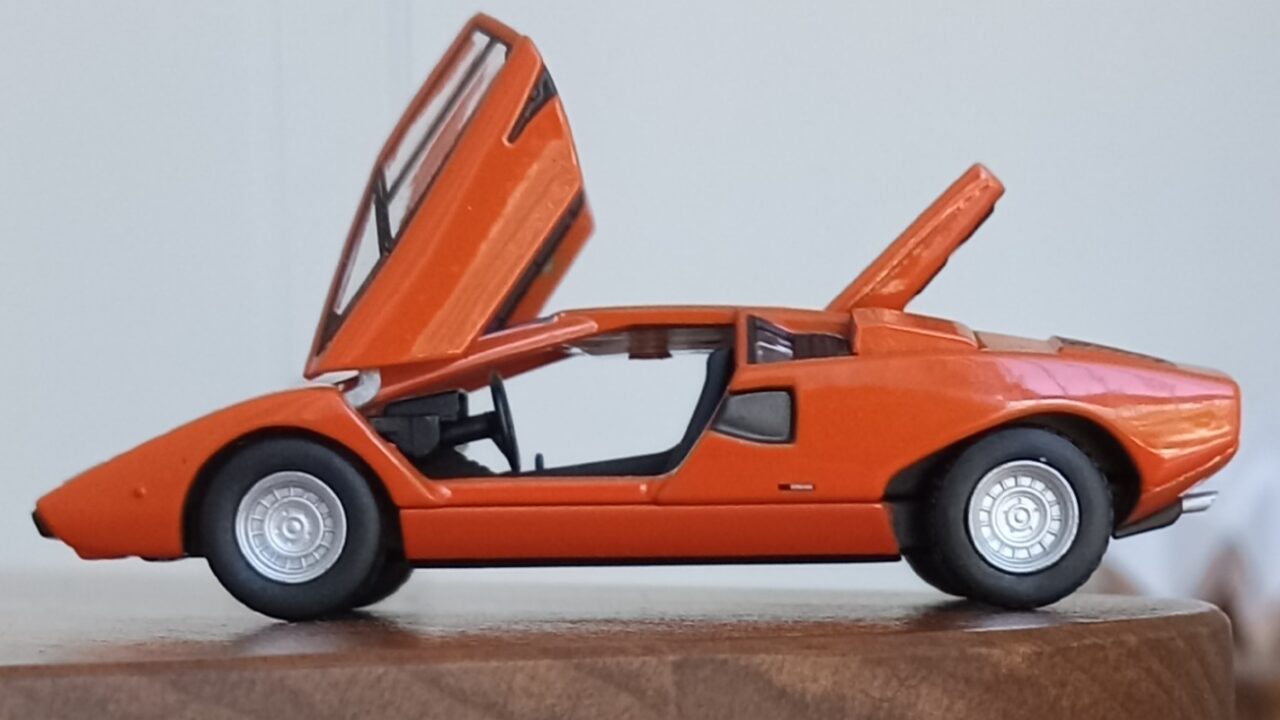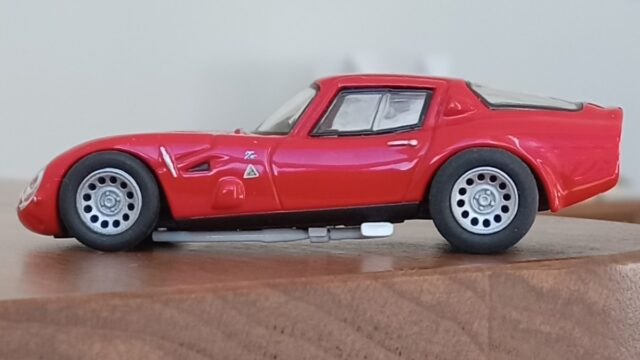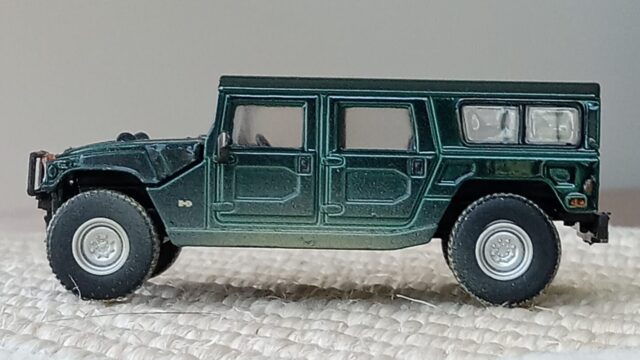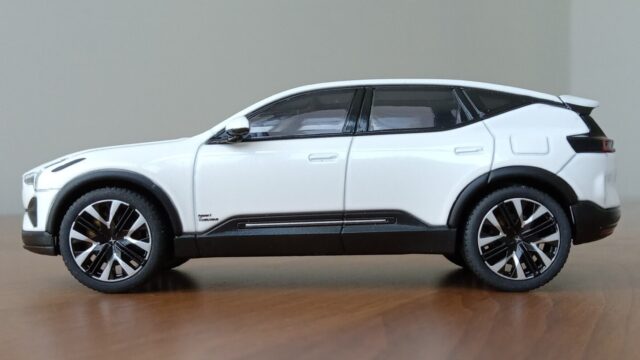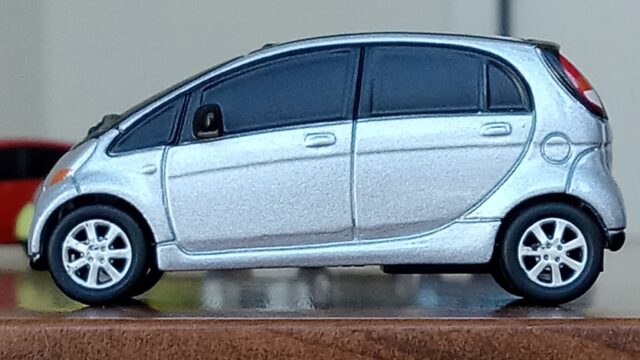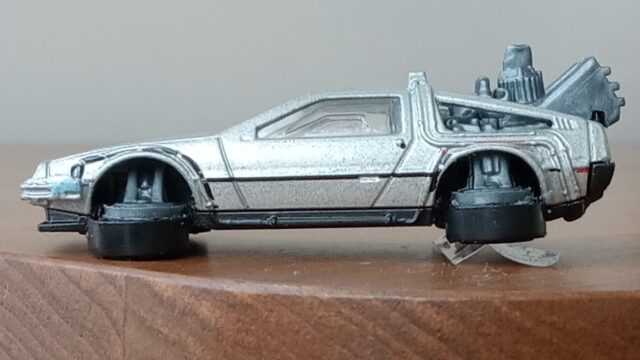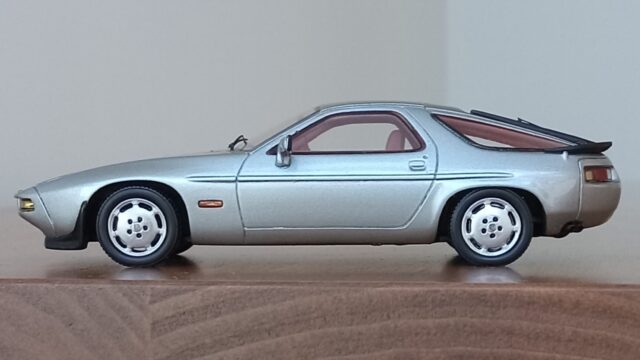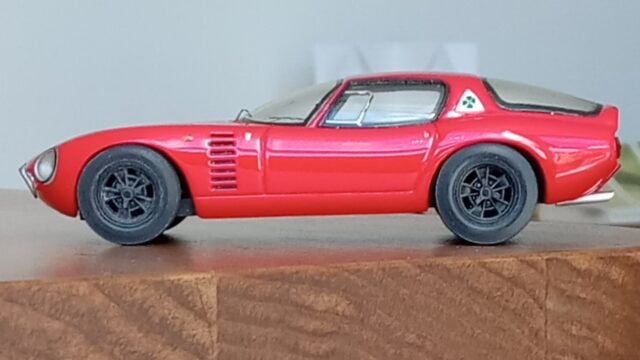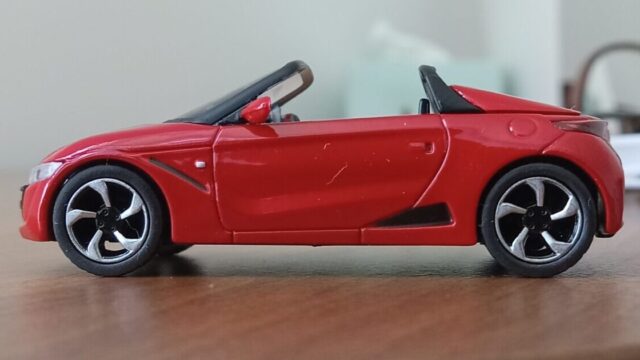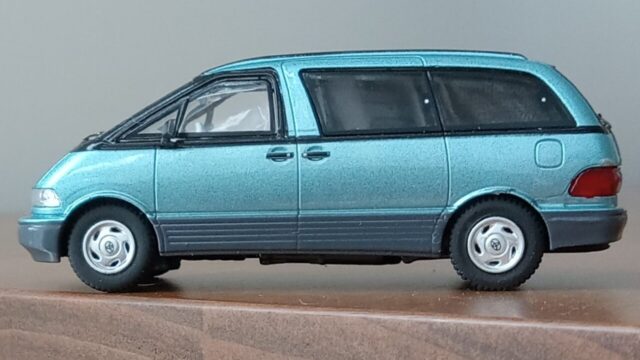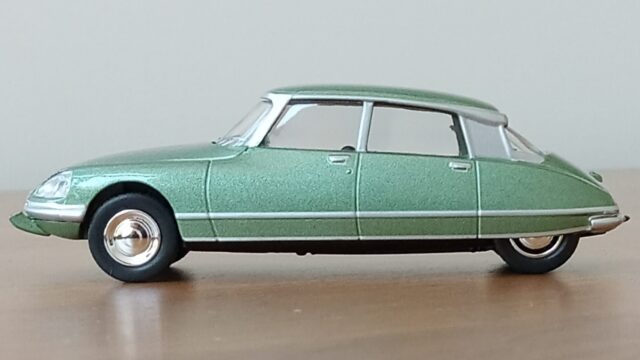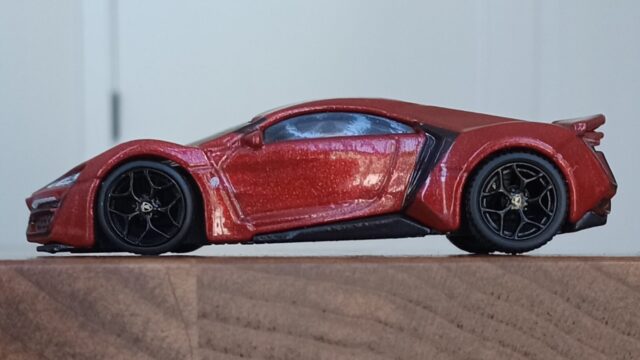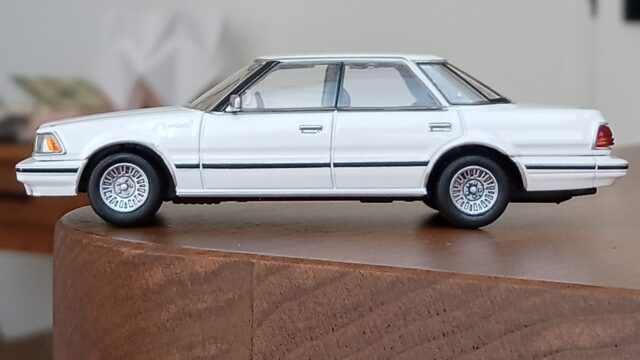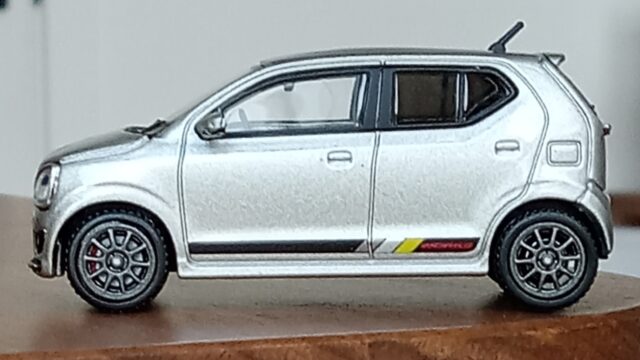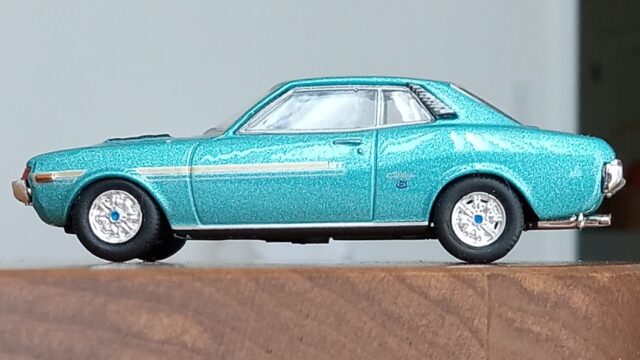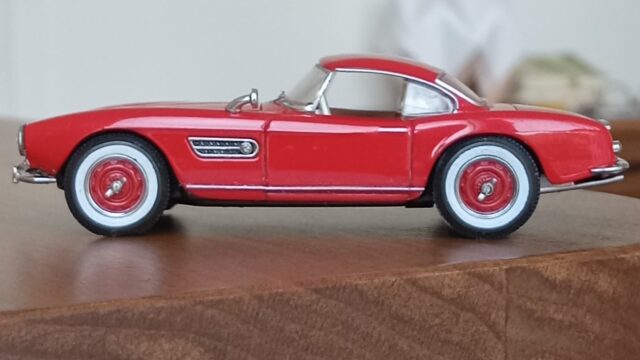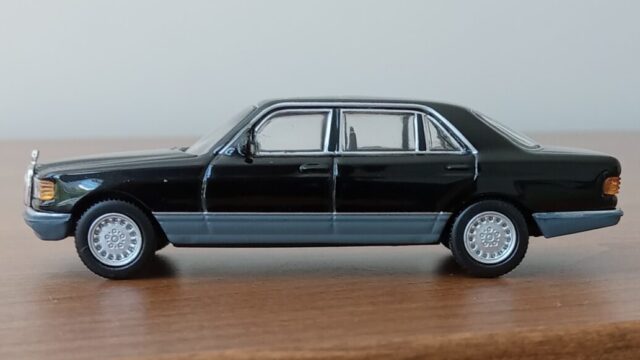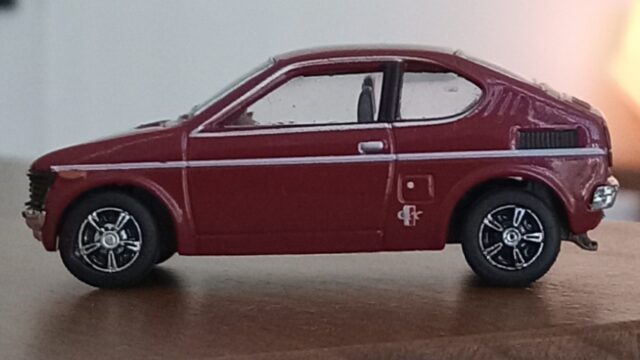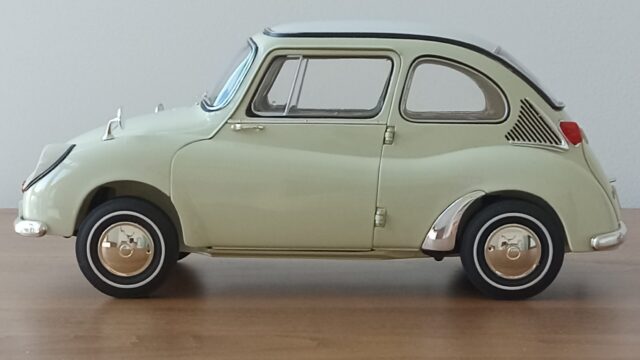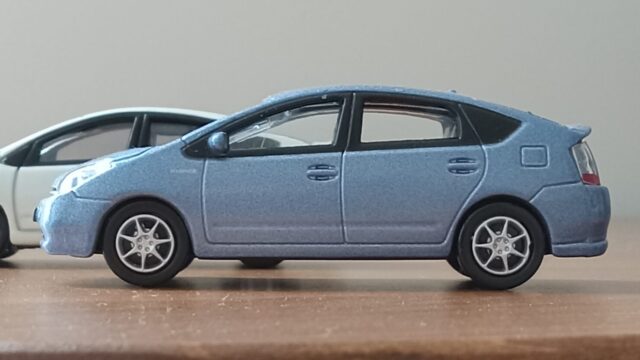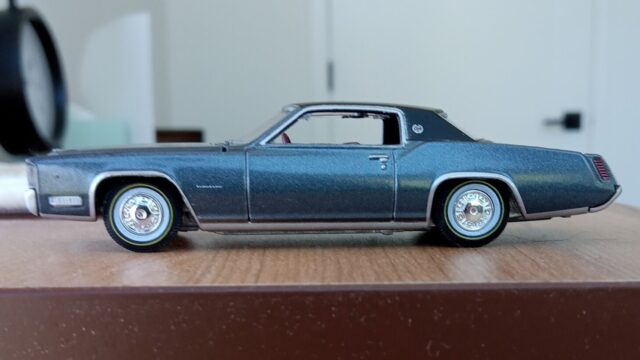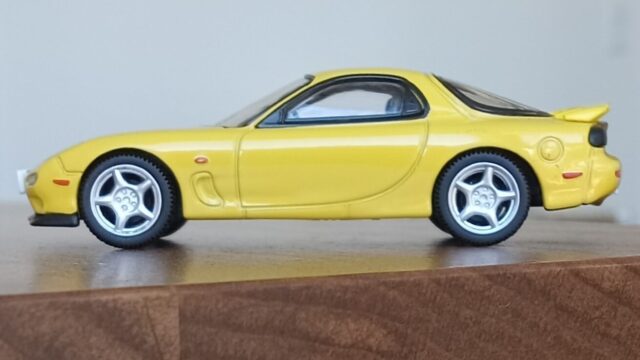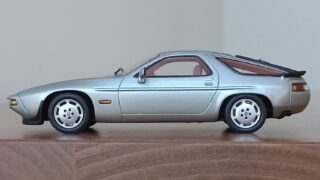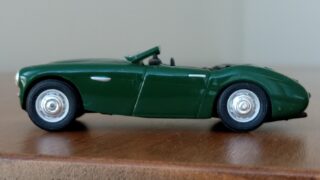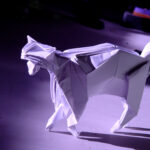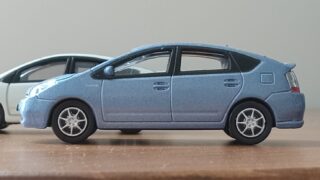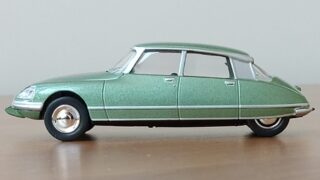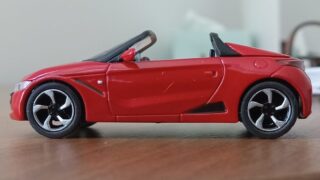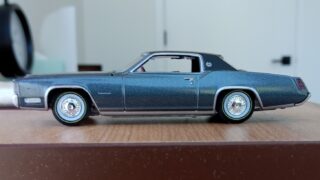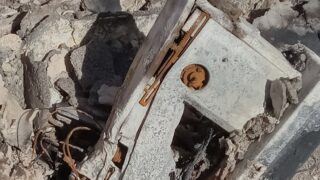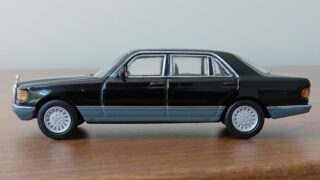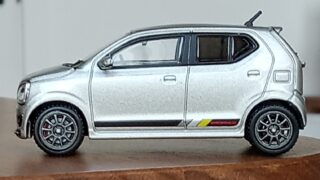デザイン・ベスト10リスト
こちらが私の独断と偏見による(笑)、
自動車デザイン・ベスト10リストとなっております。
第10位:BMW 507, 1956 ————————ーーー(シルバー+同色ハードトップ)
第9位:AMゼネラル ハマーH1, 1992 ——ー(軍用ウッドランド・カモフラージュ)
第8位:MB 560 SEL, W126型, 1979 ————ーー(黒とブルーグレーの2トーン)
第7位:キャデラック・エルドラド,1967 (メタリック・ブルーに黒のレザートップ)
第6位:トヨタ プリウス, 2003 (2代目)————————–(シーサイド・パール)
第5位:ホンダ S660, 2015 ————————————— (スター・ホワイトパール)
第4位:ポルシェ 928,1978 ————-(ライトブルー・メタに格子パターンの内装)
第3位:シトロエン DS23 Pallas, 1973 ————————(シャンペーン・ゴールド)
第2位:ランボルギーニ・カウンタック LP400, 1974 ——————ーー (オレンジ)
第1位:オースチン・ヒーレー 100/4 (BN/1), 1953 –(アイボリーと濃紺の2トン)
今回は第2位の、ランボルギーニ・カウンタック LP400,1974年型(オレンジ)についての一般評価と私個人の『LP400体験』に付いて語らせていただきます。
第2位:ランボルギーニ・カウンタック LP400、1974
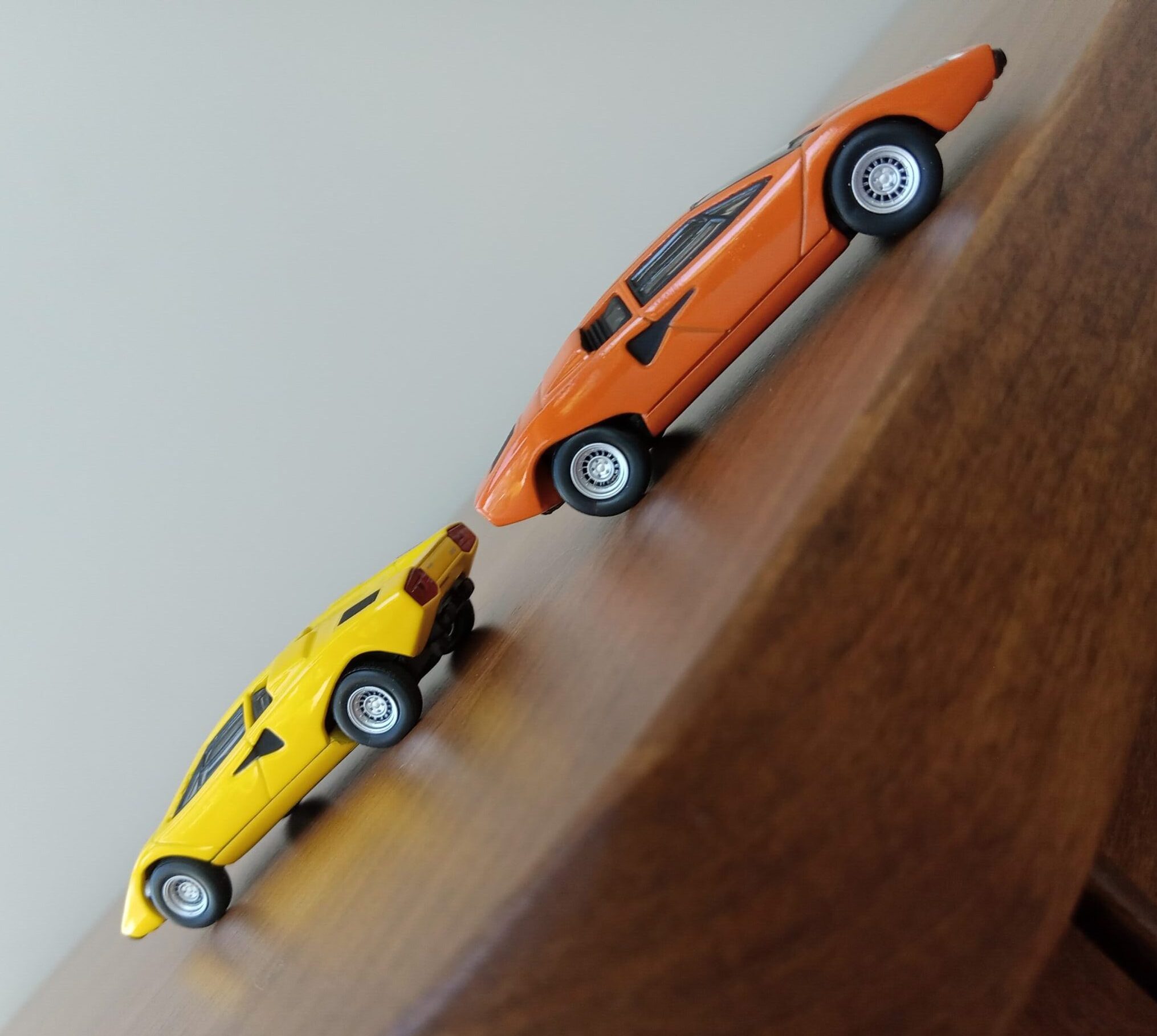
(Kyosho 1/64 Lamborghini Countach LP400 (Orange & Yellow)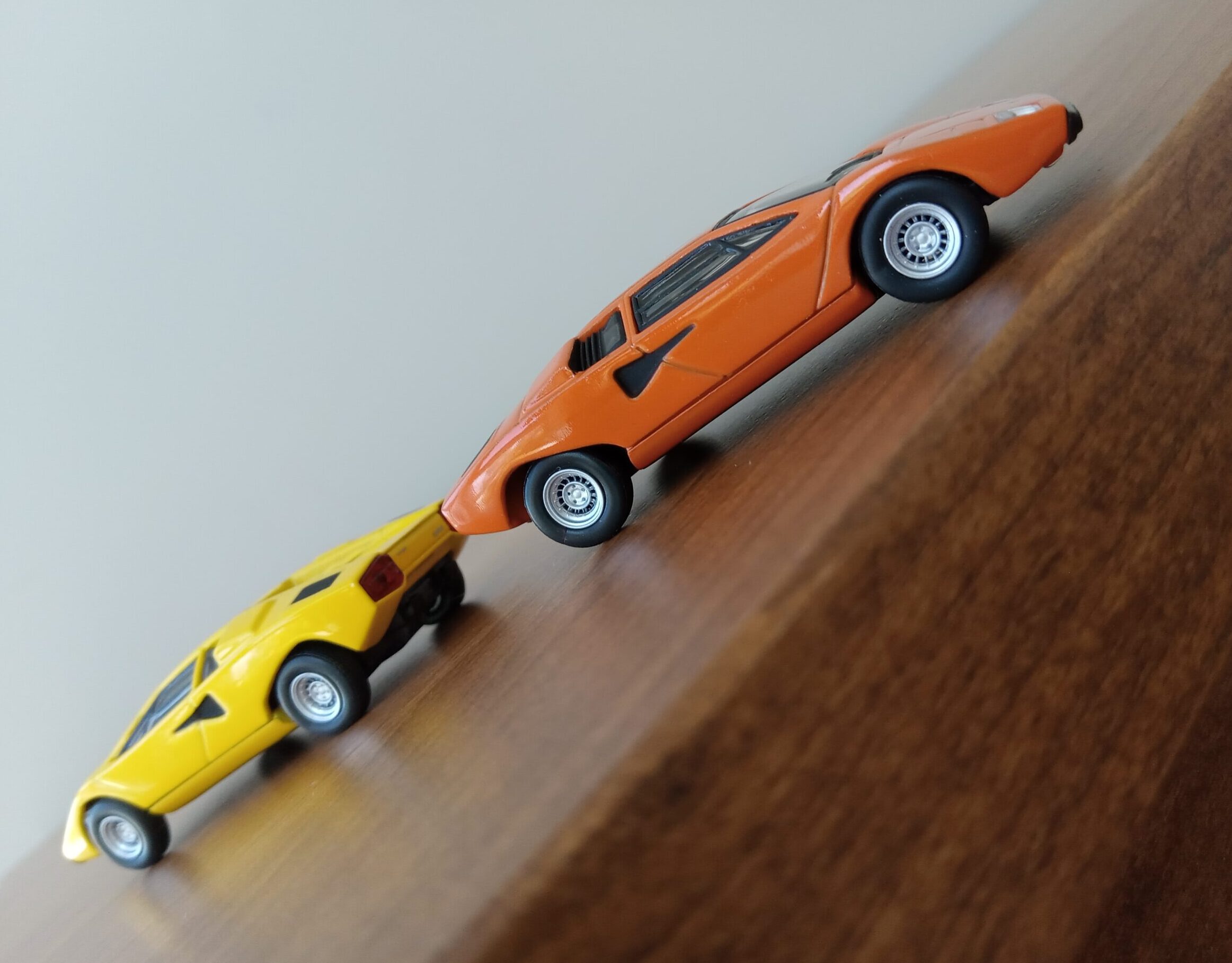
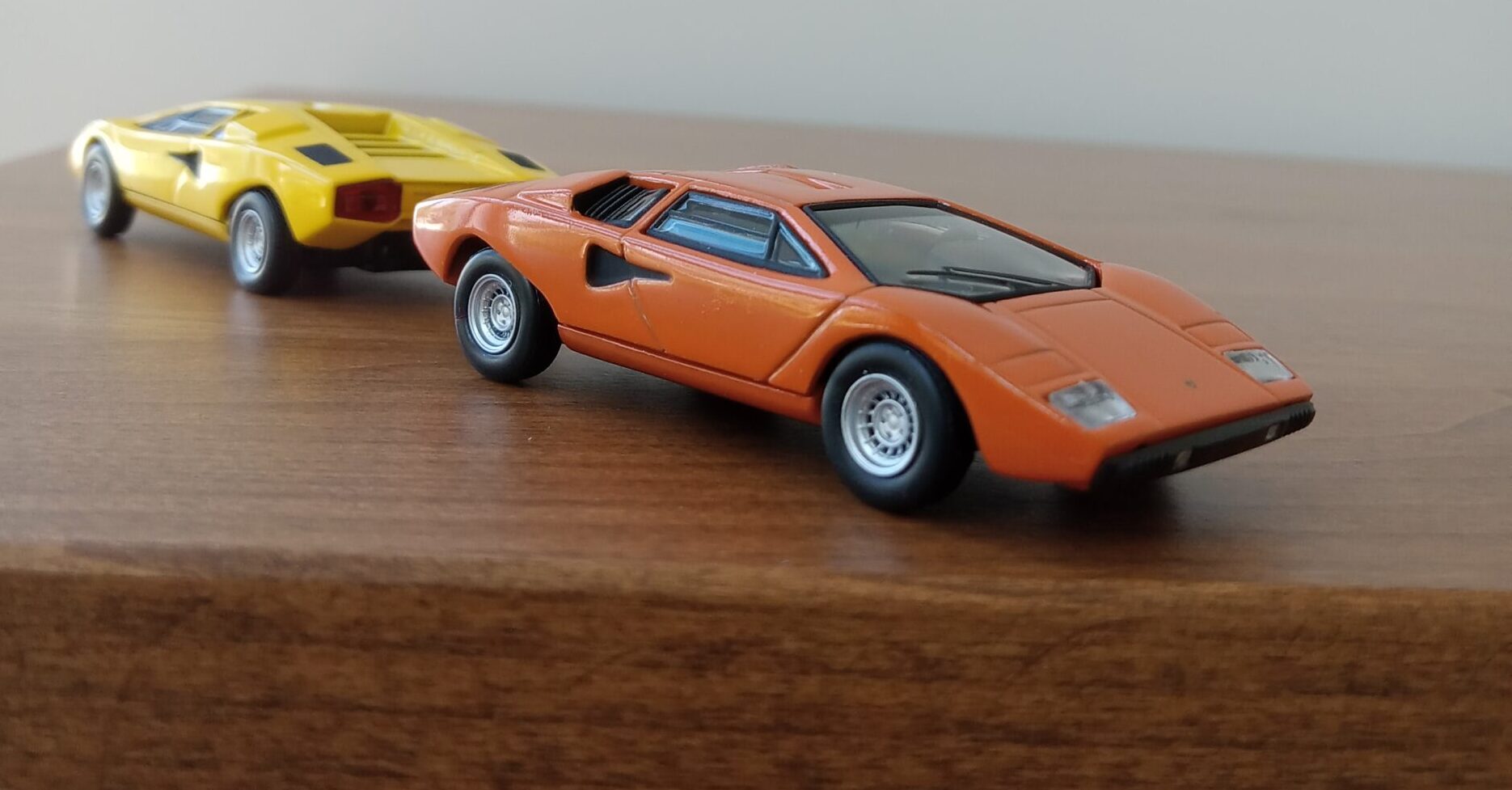
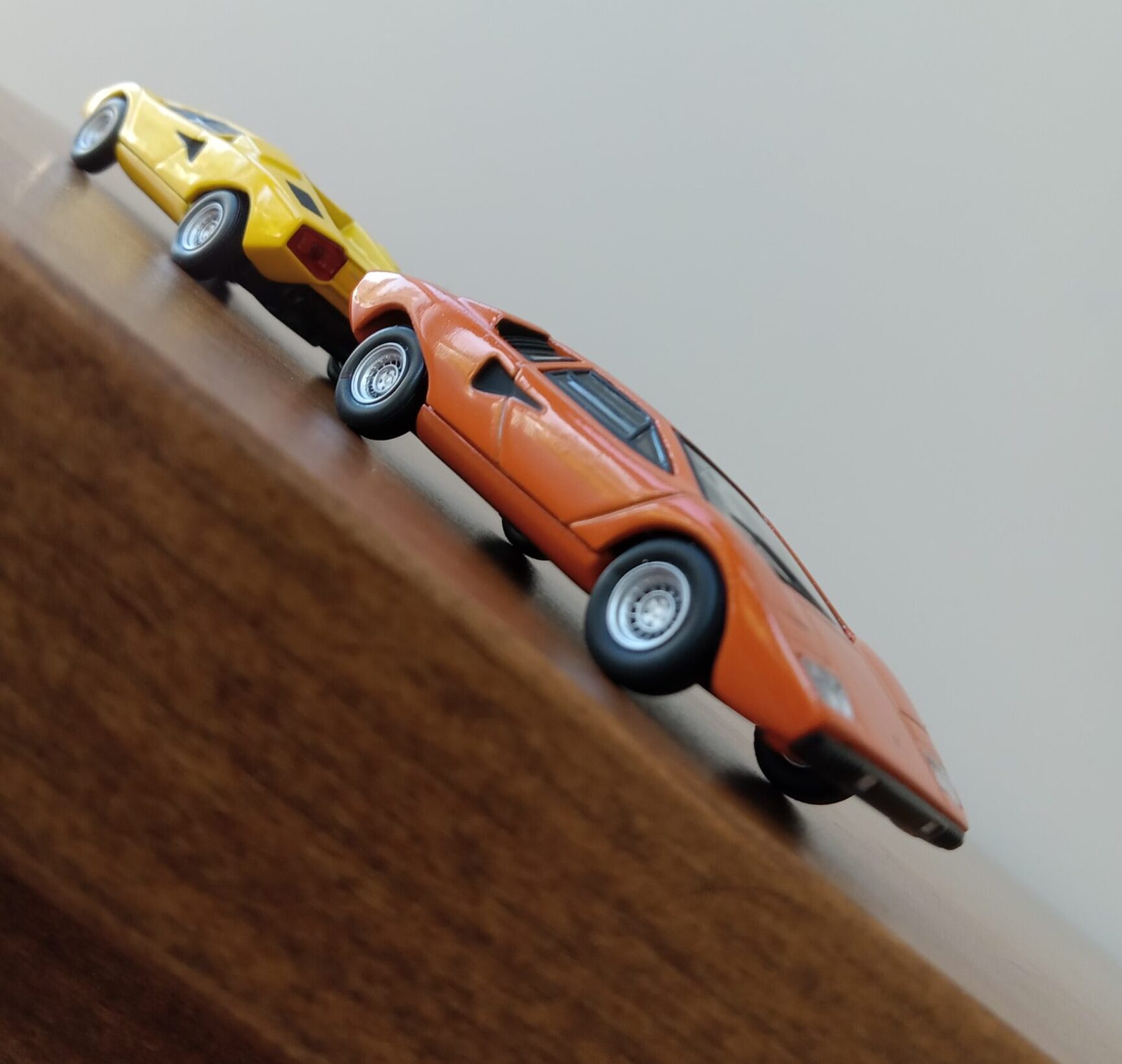
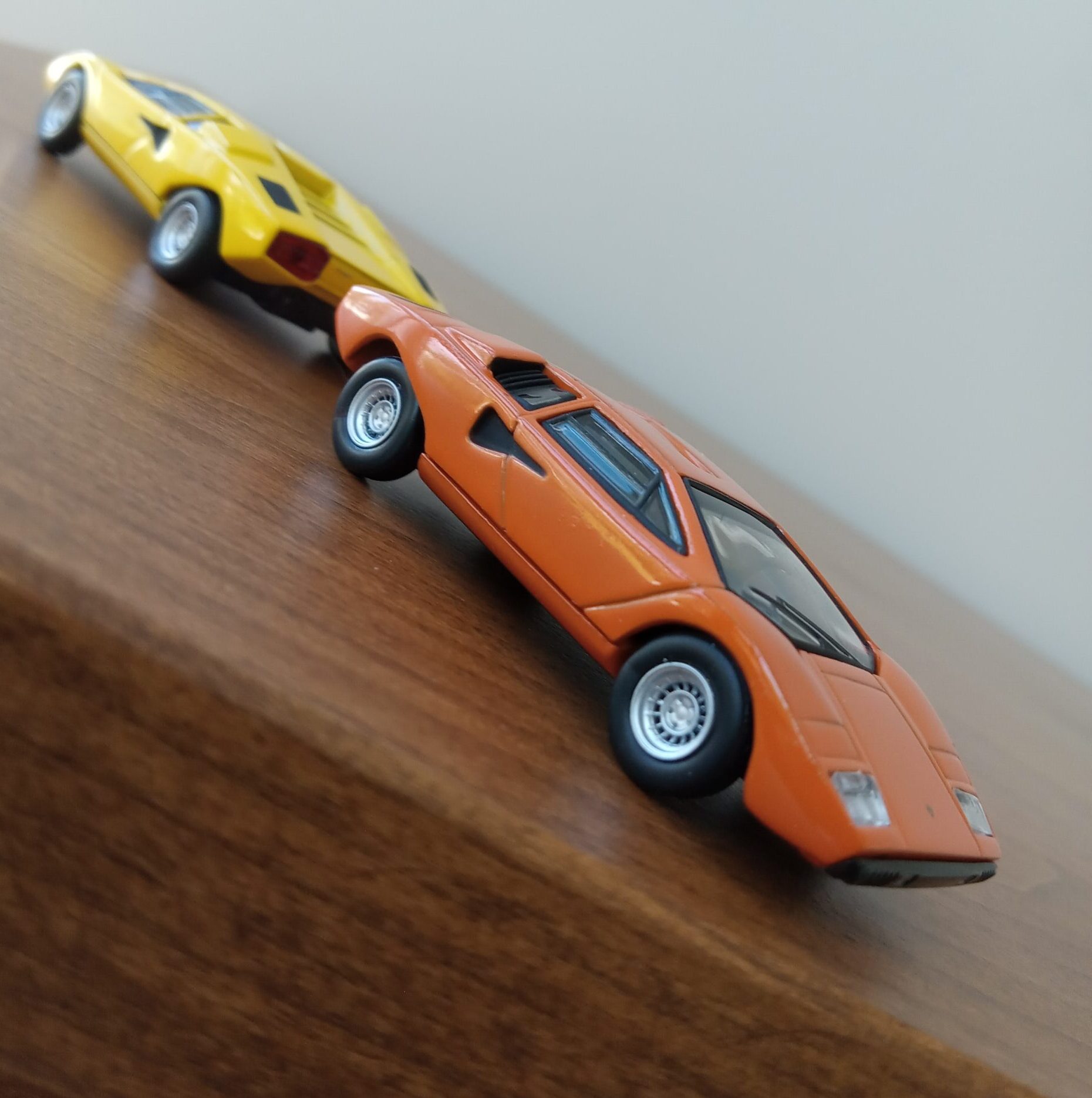

私にとって、ランボルギーニ・カウンタックLP400は、
カッコイイとか、
素晴らしいとか言う前に、
とにかく、
『カッチカチに、
んんんんん中身が詰まった、』
『超硬質』な
『くさび形、
んんん超高速ダイヤモンド』です。
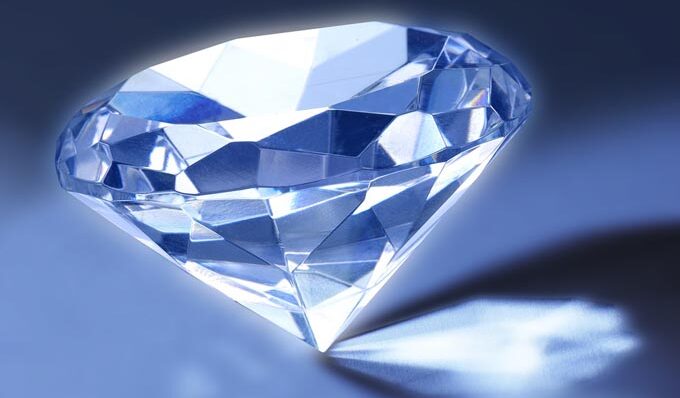
4m14cmⅹ1m89cmx1m07cmといった非常にミニマムな容積の中に、V型12気筒の巨大な心臓部とトランスミッションを、通常と逆向きに取り付けるという、創造性の塊のようなパケージデザインを、これまた奇想天外な角形ウエッジの外装で包むといった離れ業は、まさに、正に、技術者:パオロ・スタンツァーニとデザイナー:マルチェロ・ガンディーニという2人の天才のコラボレーションが産んだ『奇跡の創造物』と言って過言ではありません。
その特異な形は、他に全く比べる対象がないほどにオリジナル、立体空間のX,Y,Z軸上のどこで、どの角度で切っても、断面が『六角形』になるという、まさに高速移動可能な
『走るダイヤモンド』
と呼びたくなる、いでたちです。
実車解説:ミウラからの反省が産んだ『逆・縦置きミッドシップの怪物』
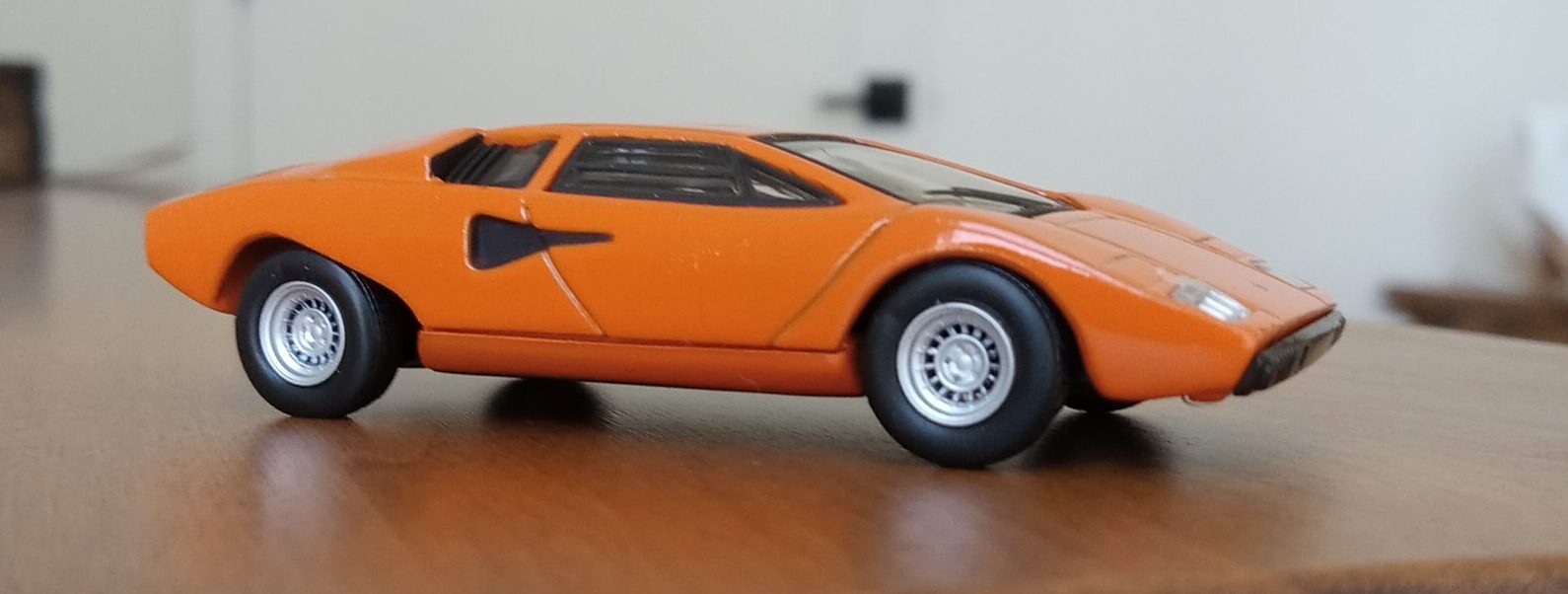
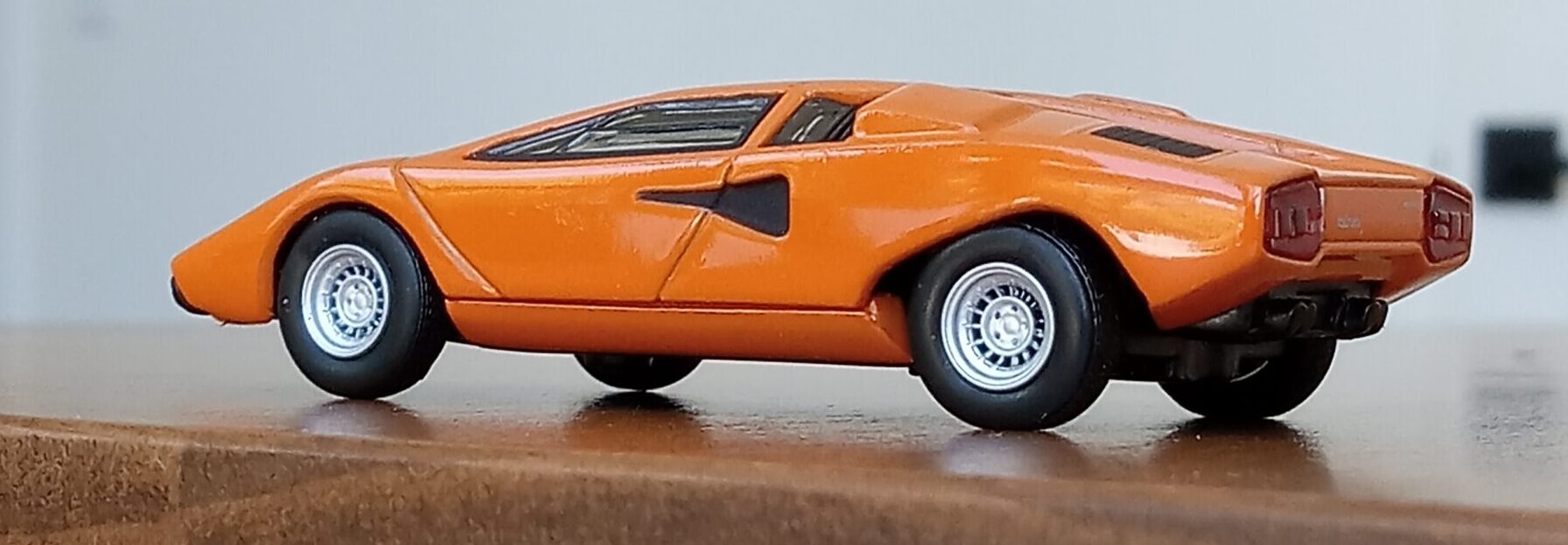
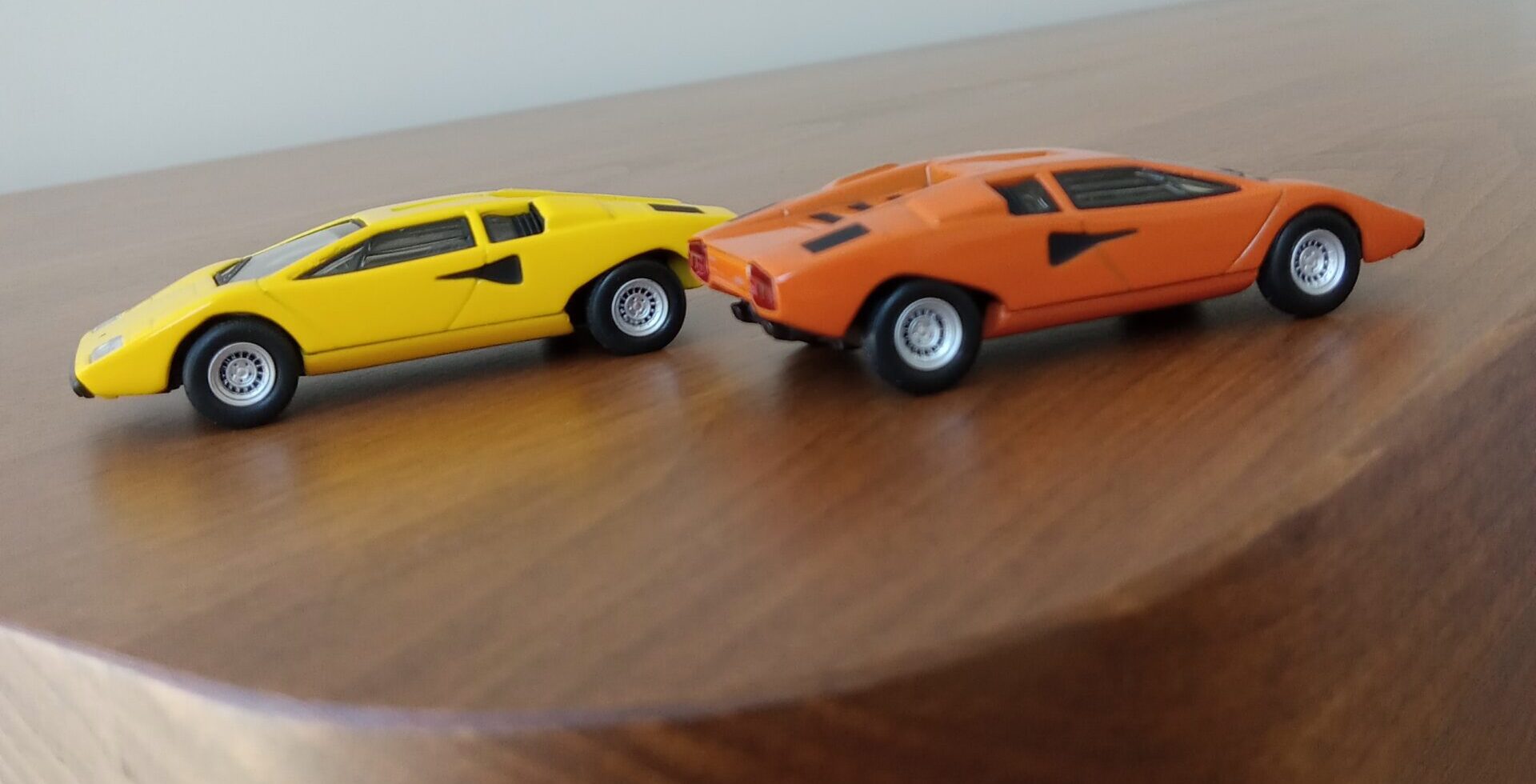
ランボルギーニのV12エンジン搭載のフラグシップモデル、先代のミウラの欠点であった、『車体重量の後部への偏りから来る旋回時の不安定さ』を解消するため、シャーシ技術者のパオロ・スタンツァーニは巨大なエンジンとトランスミッションを前後逆向きに縦置きするという前代未聞の搭載方法で、見事解決。さらには通常、シャーシ先端に置かれるラジエターをエンジン横のスペースに配置、その結果、
*質量中心が車両の中央に来ることによる、操縦安定性の向上
*高いエンジン冷却効果
*エンジンルームへのアクセス性の向上
*リンケージなしのダイレクトなシフト感
などを達成し、ミウラの弱点克服に至りました。
加えて、テストドライバーの剛性向上の進言からモノコック形式のシャーシを止め、古典的なスペースフレーム(バードケージ式チュブラーフレーム)を採用、円断面の直径30mm、25mm、15mmのパイプ鋼管が溶接された構造の美しいフルスペース・フレームに変更、その結果ミウラのそれをはるかに上回る車体・運動剛性を得るに至りました。
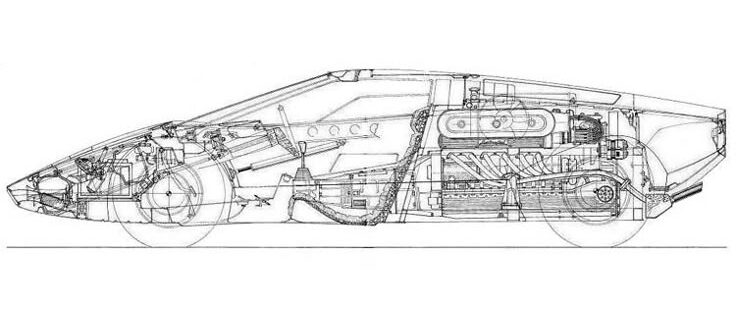 (すべての高重量の機関部が運転者の腰回りに集中する、極めてコンパクトなパケージ透視図)
(すべての高重量の機関部が運転者の腰回りに集中する、極めてコンパクトなパケージ透視図)

それじたいが格調高い芸術作品のようなチュブラー・フレームを覆うのが、天才デザイナー:マルチェロ・ガンディーニの手になる外装デザインです。デザインテーマは『プロペラのねじれ』で、彼がそれまでベルトーネ名義でデザインしたアルファロメオ・カラボ (1968年)やランチア・ストラトスHFゼロ(1970年)などはカウンタックの直接的なスタイリングの先駆けといえる存在で、
*極端なくさび形のウェッジシェイプ、
*低く平らなフロント、
*切り詰められたテールエンドのデザイン
等にその萌芽を確認することができます。カウンタックの近未来的なデザインは、車名通り世界中に驚きをもって迎えられました。
初代カウンタック・シリーズは1971年から1998年まで改良を重ねながら生産され、16年間で合計1,999台を販売、今日まで世界中の愛好家によって、程度よく保存されているものが多く存在し、今もなお『スーパーカーの中のスパーカー』の称号を欲しい侭にしています
選考理由:そのデザインの客観的評価
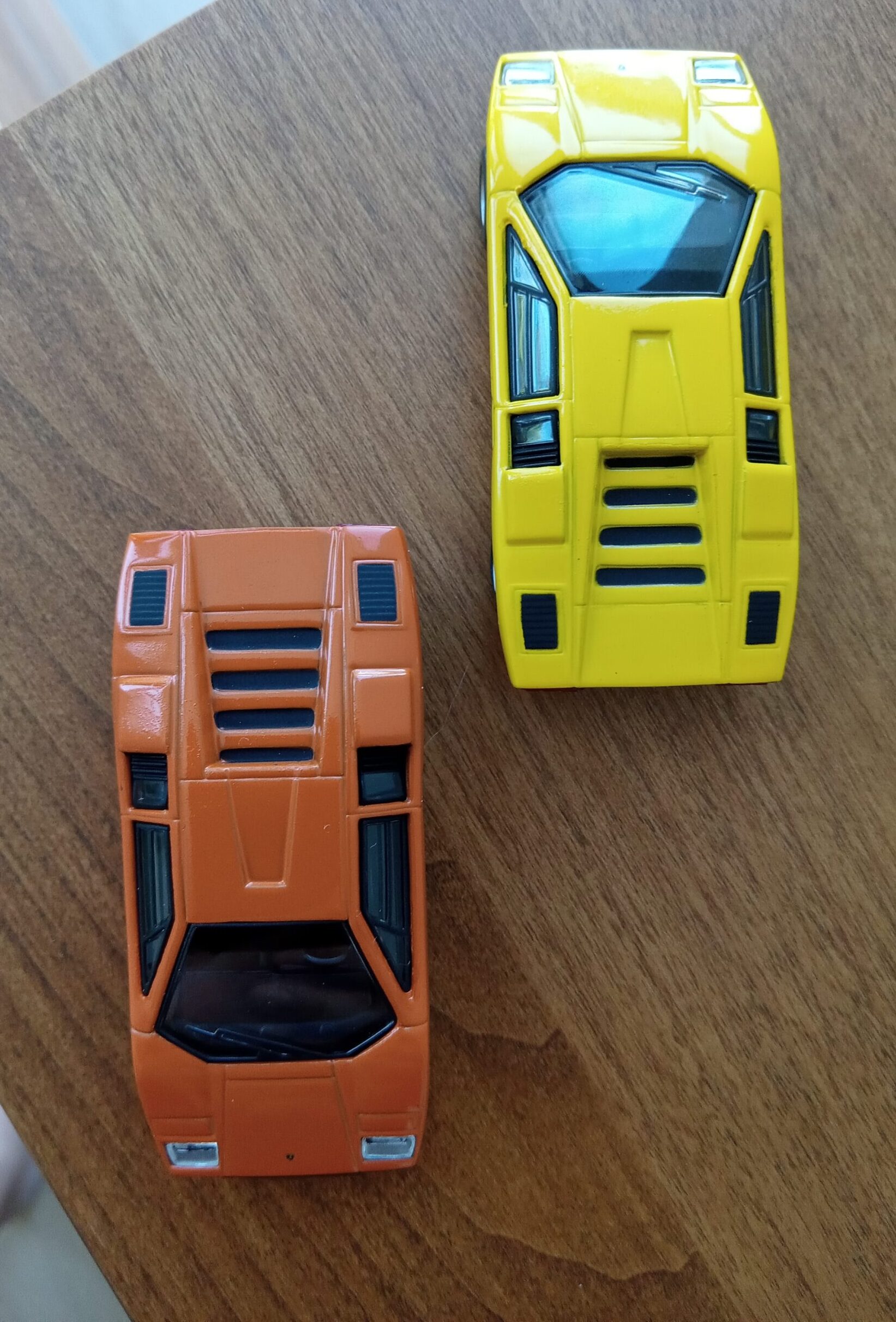
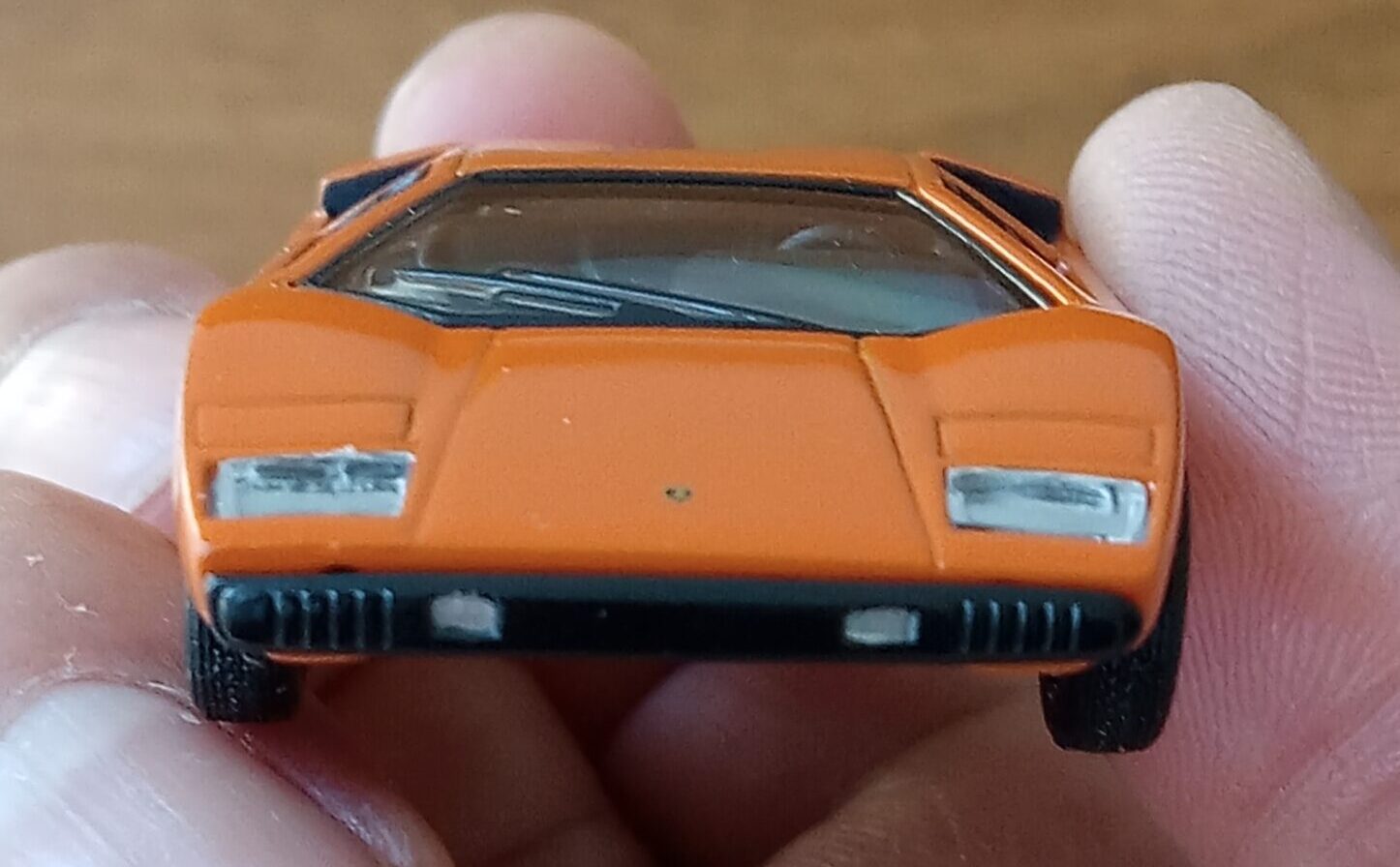
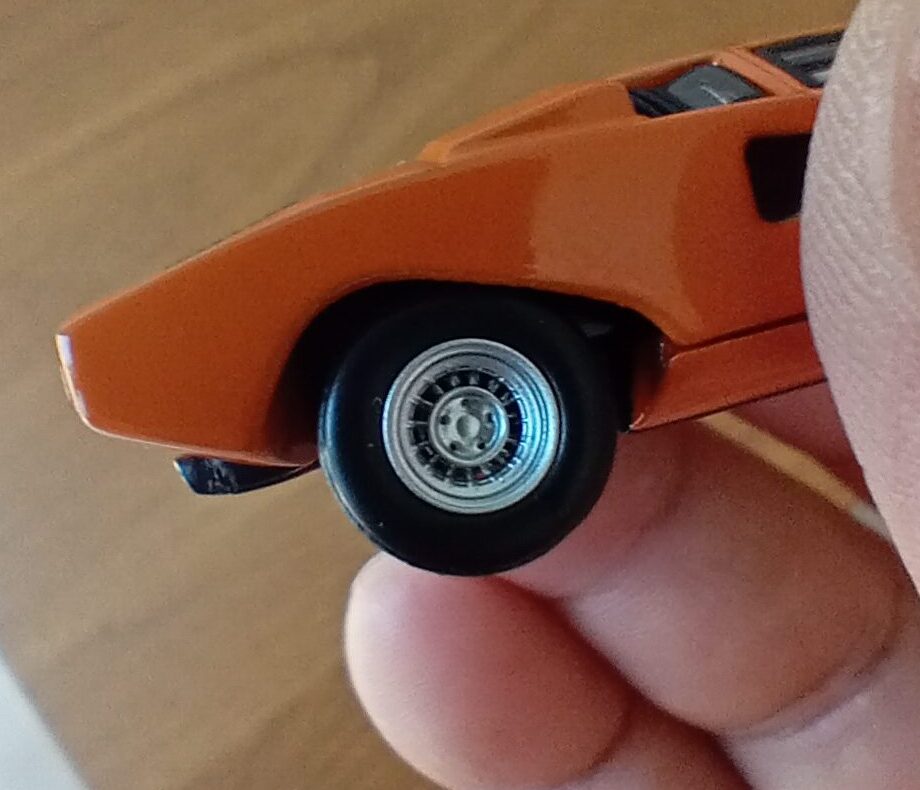
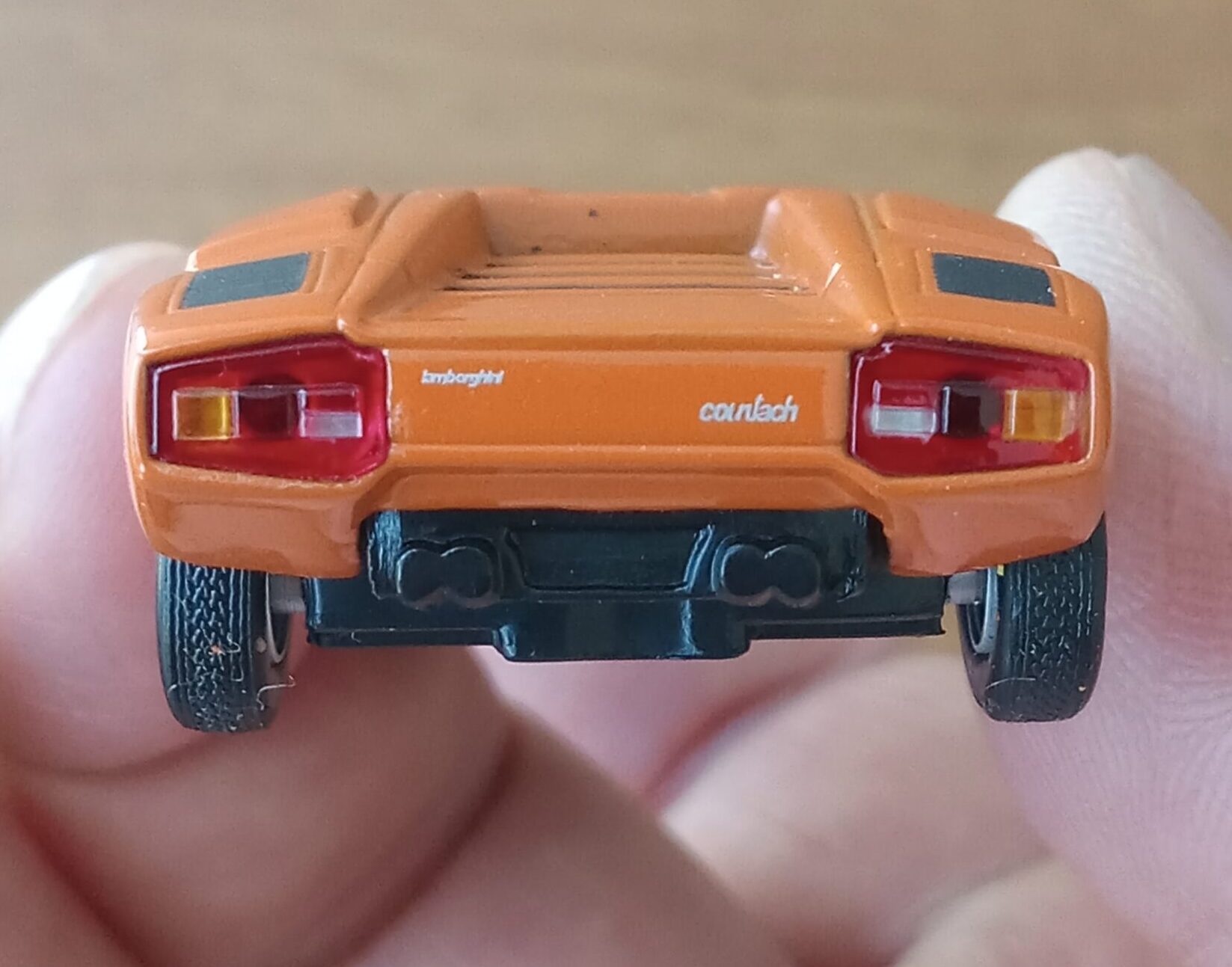
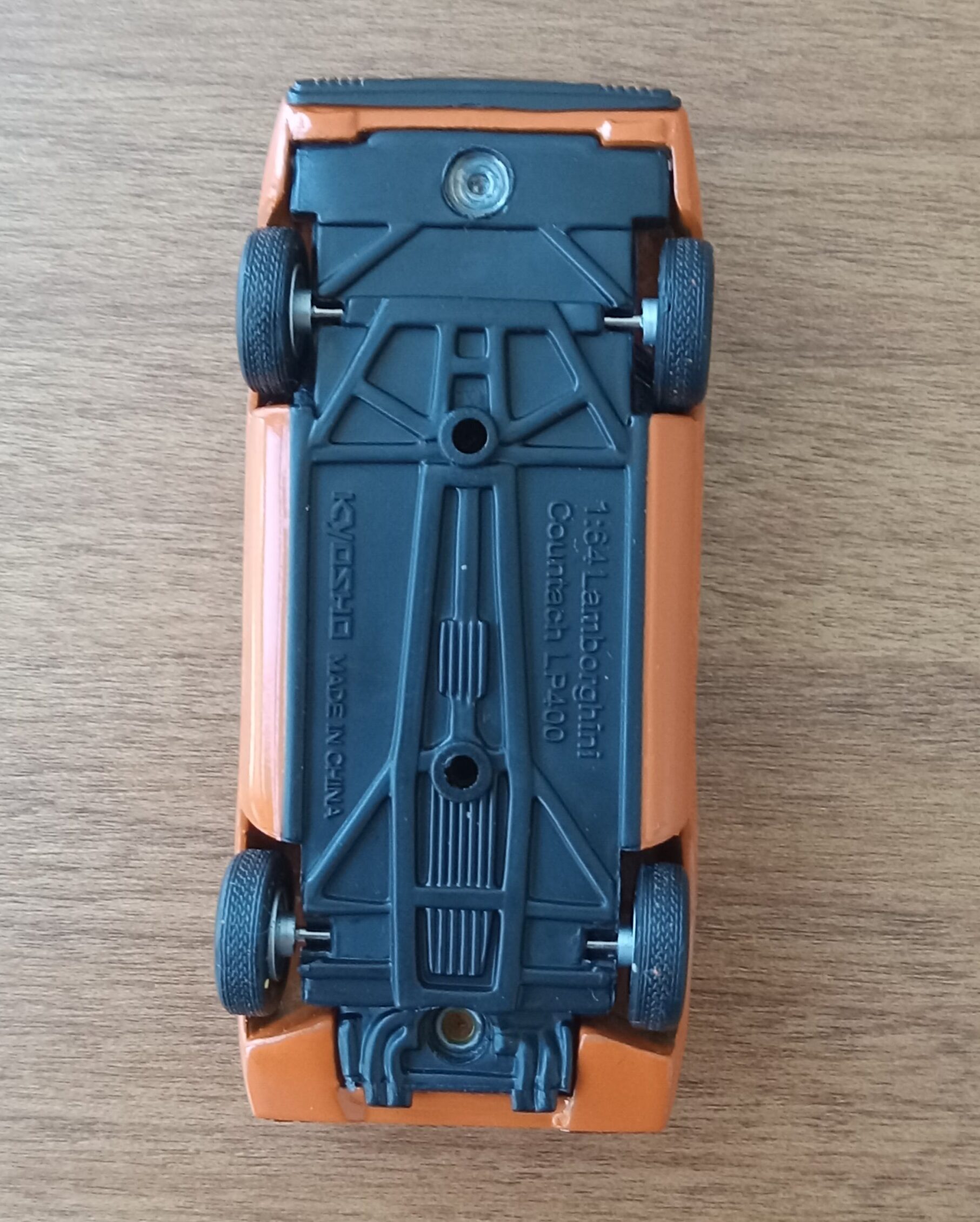
それでは、次に外装デザインに絞って、その特徴、テーマやモチーフについて述べさせていただきます。(ここでは、カウンタックの外観のテーマがはっきりと明確な、初期バージョンLP400についてのみ検証せていただきます。)
以下のポイントに絞って解説させていただきます。
*ボディー全体の『ウエッジ』シェイプ
(カウンタックをカウンタックたらしめる、最重要テーマ、よく見ると、後述する『8角形テーマ』もウエッジのチューニングに貢献しています。)
*ボディー・ショルダー上面のテーマ:『プロペラのひねり』
(サイドウインドウ部分では20度くらいあった面の角度がテールエンド付近では5度程度まで緩やかになる『面のねじれ』をプロペラのひねりから着想。(この『ねじれ』がサイドビューのリアフェンダーの膨らみと絡むことで、得も言われぬ緊張感と異質感が生み出されています。)
*随所に散見する、『8角形』と『台形』モチーフ
(ボディーのX/Y軸上、どこで輪切りにしても現れる『8角形(6角形?)』の断面と随所にみられる2次元の『台形』テーマがカウンタックの『ダイヤモンド』のような硬質感をビジュアル面から担保、さらには実際的なチュブラー・フレームによる剛性の達成と合わさりその『カッチカチ』ボディーが完成)
カウンタックを魅力的に飾る細部のデザイン
*元祖『シザース・ドア』
(アイコンとして、かつドア開閉時のスペース確保のため、カウンタックから始まり、その後の12気筒搭載のフラッグシップ・シリーズ・ランボのシンボルとなる、上方はね上げ型の『シザース・ドア』)
*グラフィック・アイコンとしても特徴的な『NC・ダクト』
(きわめて明確な方向性を表す『NCダクト』は、くさび形(ウエッジ)の強調にも一役)
*力強い『テールライト周辺の造形』
(前後からの衝撃に『いかにも強そう』な2重六角柱のリアエンドはビジュアル的にも、物理的にも最強!!)
*ドア断面のタックインと特徴的なフェンダーアーチ
(デリケートに微調整されたボディーサイド下断面は最終的にはかなりボディー底面を削り、同じく熟慮の上開けられたリアホイールアーチと相まって、(LP500S以降のフェンダー・フレアーで台無しにされることなく)バイアス式リアタイヤの優雅な踏ん張り感を陰から演出)
*ボディーサイド全面やフェンダーンの膨らみ部分等にみられる、繊細な凸断面(直線的に見える全体像ですが、要所要所で繊細なチューニングを受けて全体のふくよかな陽性なキャラをしっかりと支えています。)
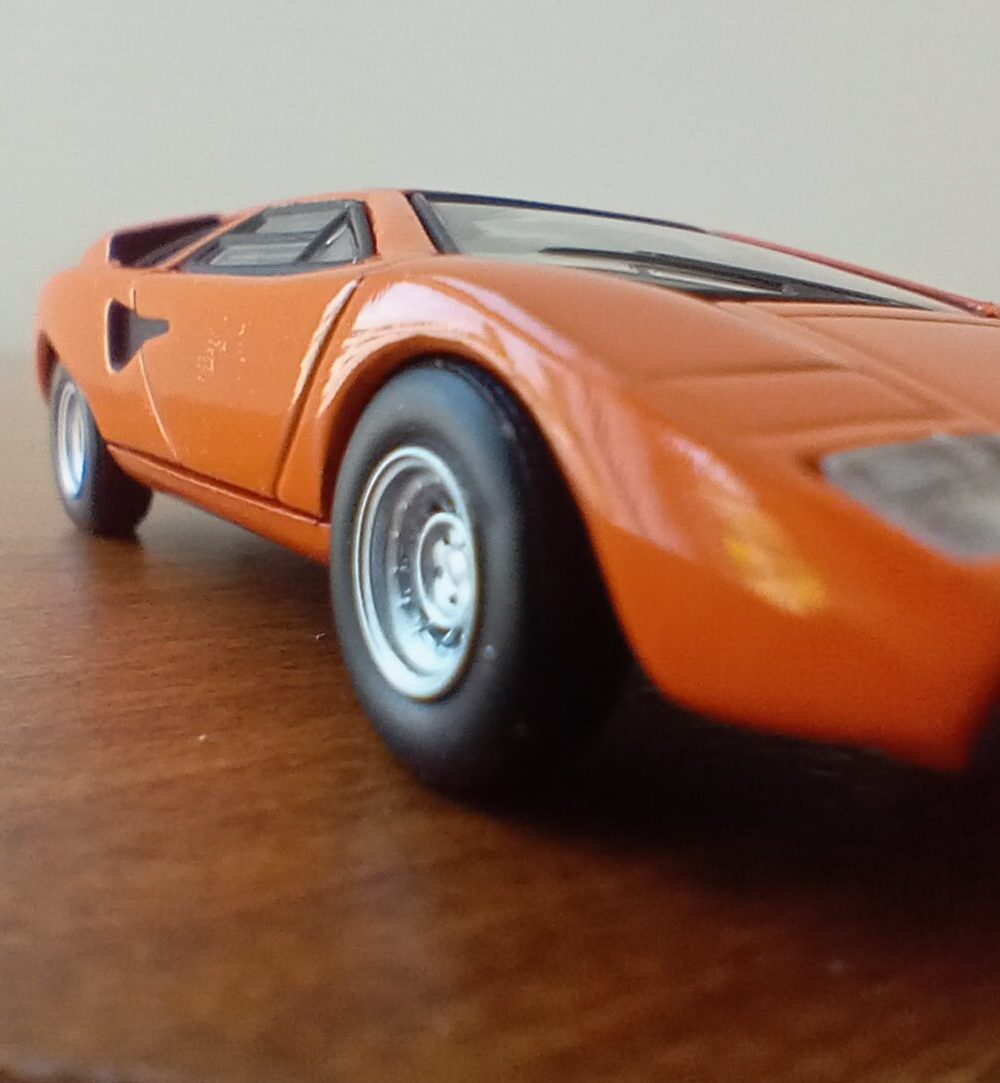

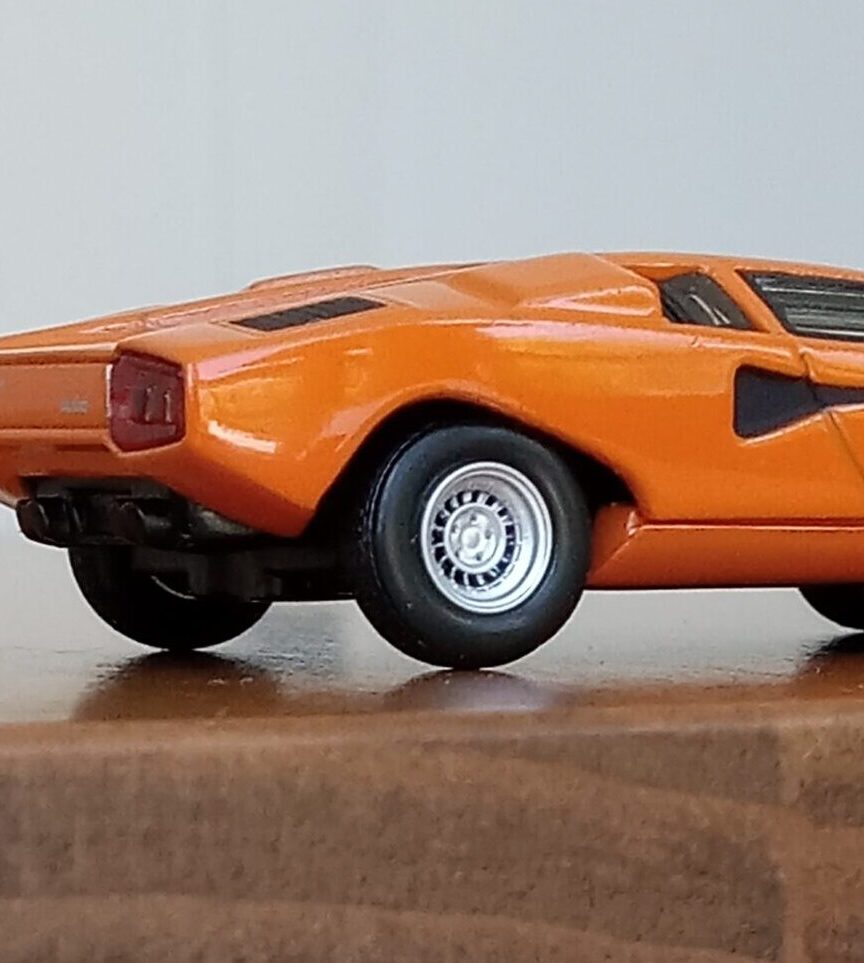
私とカウンタック:『驚嘆の感嘆符!!』
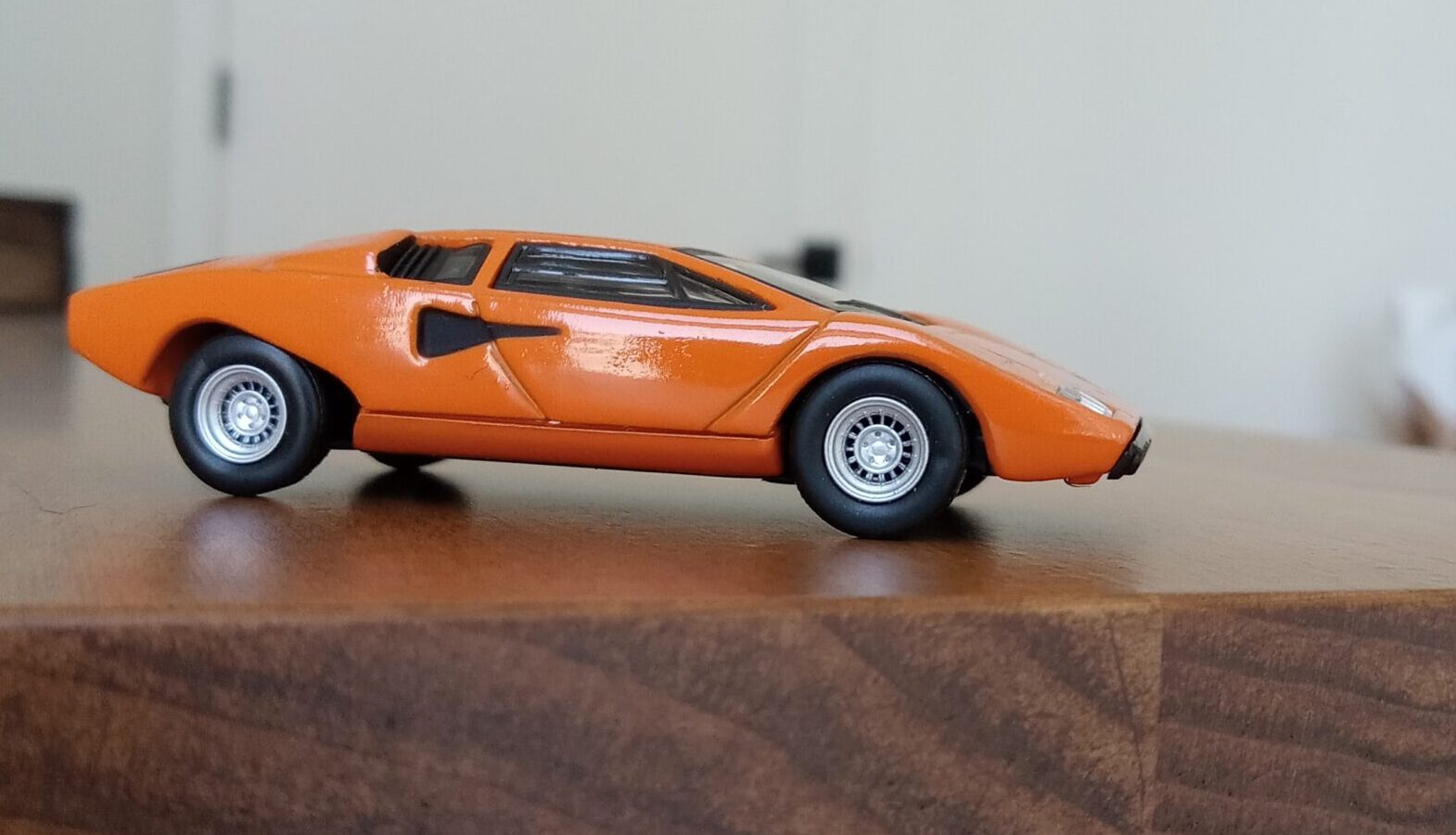
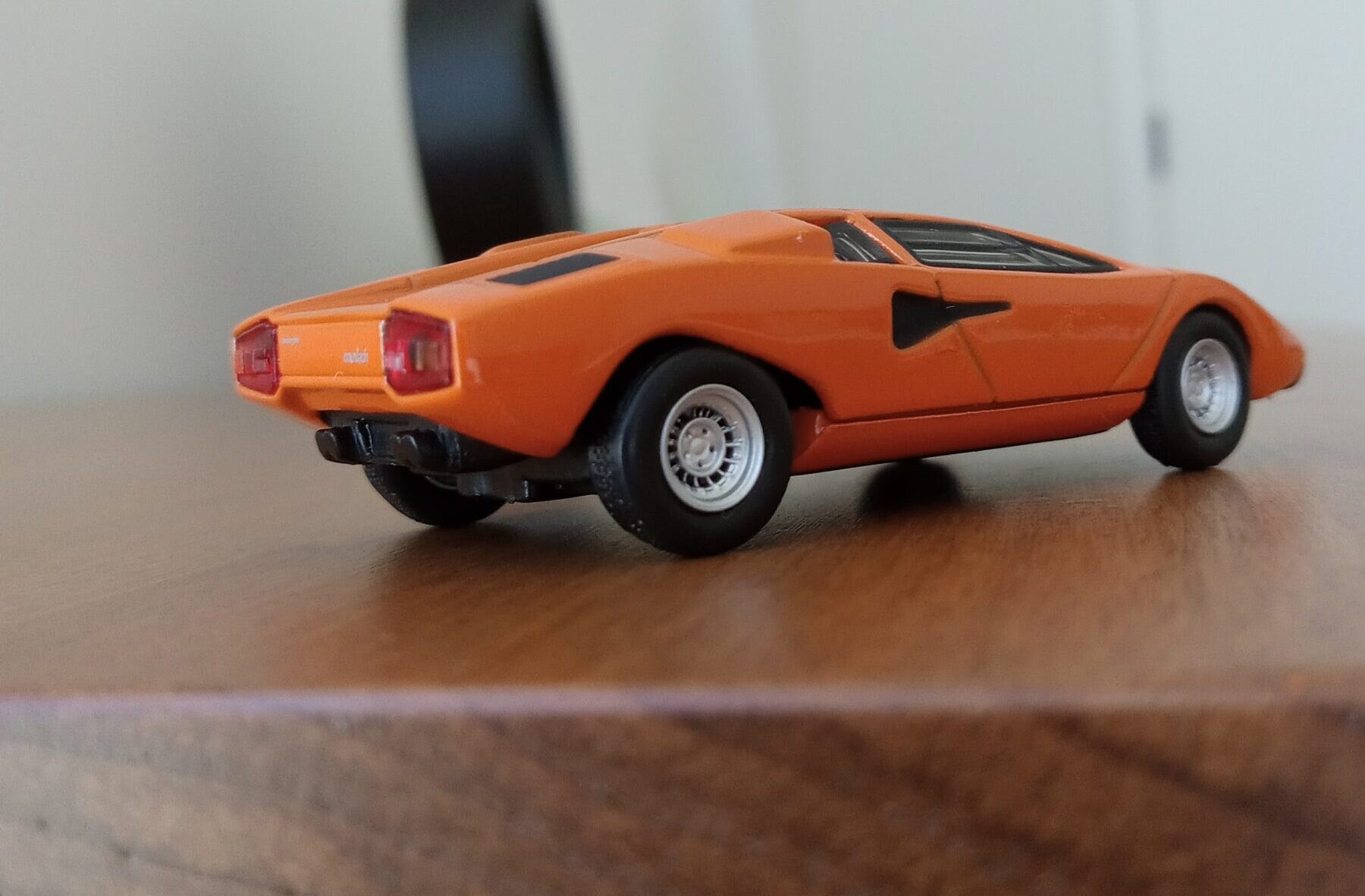
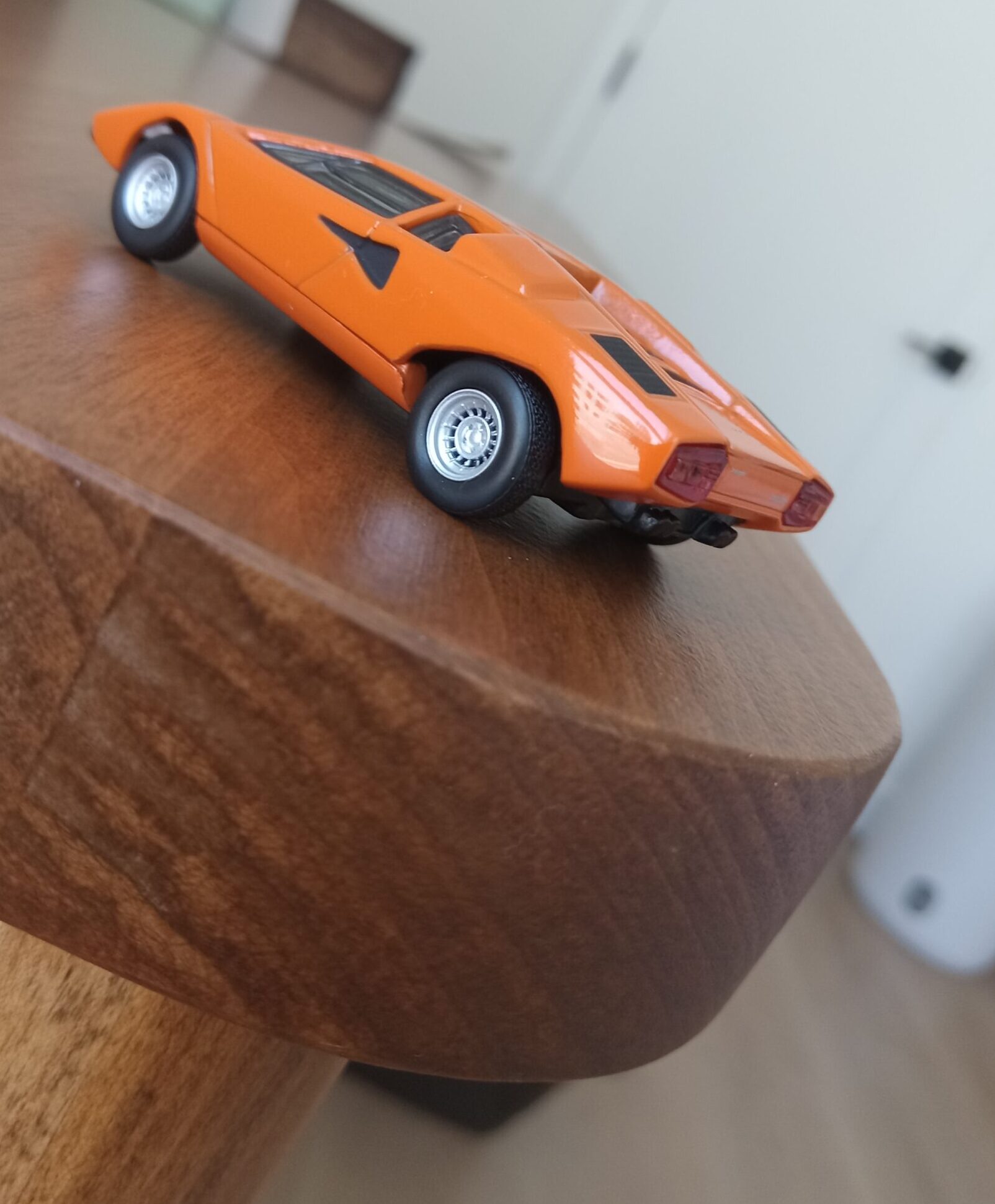
イタリア北西部のピエモンテ方言で、
『何だこれ!』
という驚愕の感嘆詞が、
『カウンタック』という名前の意味だそうですが、
私が中学一年生の時に、スパーカー・ショウ会場にて、初めて見た時の感想も、
中部地方の名古屋方言で、
『で~りゃ~、カッケーがや~!!』
(訳:すごくかっこいいね。)
というものでした。
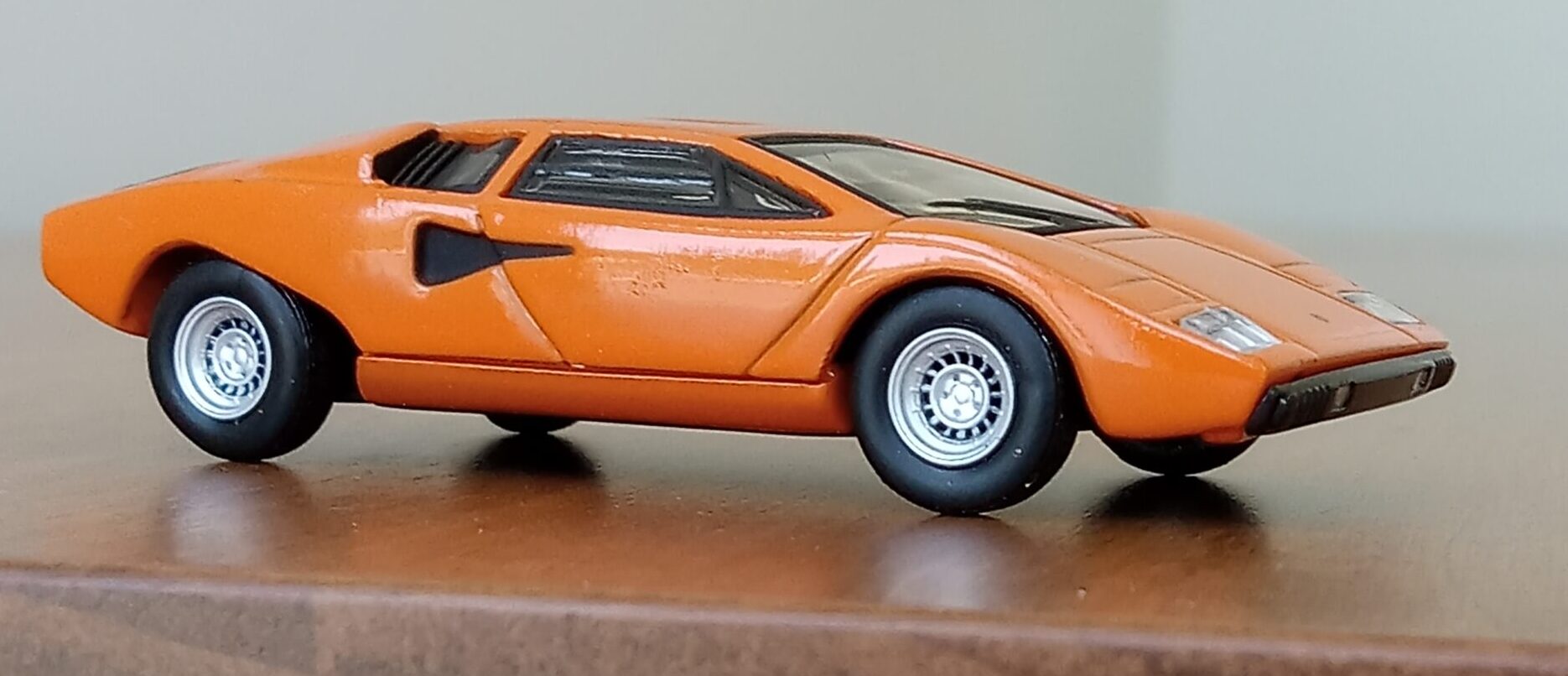
既にスーパーカー消しゴム、東京マルイやアオシマ製のプラモデルで、
知っていたはずのその、
『低く、とにかく低く』、
『広ーーく』、
『カクカク』で、
『三角(くさび形?)』。
と言った、
トンデモナイいでたちの、オレンジの怪物にどう対処していいのかわからず、一緒に来ていたM君と興奮状態で、慣れないカメラのシャッターを切りまくっていました。
またそのショーにはフェラーリ512BB、パンテーラGTS, ランボルギーニ・ミウラ 等も来ていたはずですが、それらのことは全く記憶にありません。(後で気が付いてみると、フィルムの入れ間違いで全く写真は撮れてませんでした、、、泣)
その後のさらなる
『カウンタックとの遭遇噺』
中学の3年のころ、リドリースコット監督の恐怖SF映画、『エイリアン』を弟と鑑賞後の帰り道、バス停付近に停車中の黄色いLP400を発見、同じくクルマ好きな弟と、『かぶりつき状態』で眺めまくっていると、(誰か乗車中とは知りませんでした、、)突然上に90度展開したシザース・ドア。ドライバーの中年の紳士から『ちょっとそこら辺を乗せてせてあげよう』と言われ、フェラーリ512BBファンの弟を押しのけ、私を載せたLP400は名城公園の周りを軽く一周(3-4分)して戻ってきました。
乗車中の記憶はこんな感じ、
*『高い』センタートンネルと、太いドアシルに囲まれた助手席シートの安心感と、
*それとは裏腹に、脚が短くて靴底が安定せずぶらぶらとした不安感という
*アンビバレントな記憶としてうっすら覚えております。
こんな体験もあり、
(後年、バードケージが創り出す『剛性感がすごい』といわれたとき何かピンとくるものがありました。)
立体模型的『遭遇噺』
次に、
プラモデルや、ミニカー、ダイキャスト模型にまつわる経験はどんな感じでしょうか?
*東京マルイ1/24 カウンタックLP500(メタリック・ブルー)
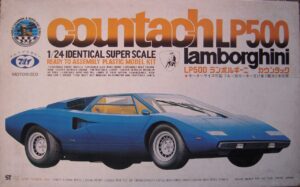 (『シザースドア』の先端がボディーの内側に入るディーテールを再現した伝説的なキット。何度も食い入るように眺めたのち、実写鑑賞後にボディーの平べったさが少し大げさなのに気づいてからは、ご無沙汰状態。)
(『シザースドア』の先端がボディーの内側に入るディーテールを再現した伝説的なキット。何度も食い入るように眺めたのち、実写鑑賞後にボディーの平べったさが少し大げさなのに気づいてからは、ご無沙汰状態。)
*タミヤ 1/24 カウンタックLP400(ホワイトボディー)
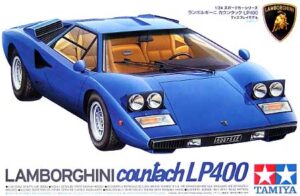 (こちらは白いボディーで、厚みがあり、ボディーサイドやフロントフェンダー周りがふくよかな印象でした。マルイ版ほどの強い印象はありませんが、、、)
(こちらは白いボディーで、厚みがあり、ボディーサイドやフロントフェンダー周りがふくよかな印象でした。マルイ版ほどの強い印象はありませんが、、、)
*オオタキ 1/12 カウンタックP400 (ホワイトボディー)未買
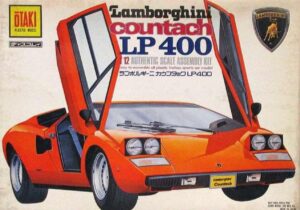
(このキットは、行きつけの模型やで何度も、中身を観察後、ふたを開け閉めして15年ぐらい過ぎたころ、意を決して買いに行ったところ既に売り切れてました。(泣) リアシャーシ、リアサス周りの作りがすごく精密なのと、取説が50ページ以上あり本みたいだったのを覚えてます。)
*1/43 ダイキャスト製ミニカー群
大学卒業後、渡米してからは、専ら1/43のダイキャストにてLP400と接するようになりました。
#ミニチャンプス製 1/43 カウンタックLP400(Yellow)
(ミニチャンプらしい優等生的なとらえ方、塗装が厚すぎ、ドア回りのモールドが甘いのが弱点)
#MRx京商のコラボ商品、カウンタックLP400、(ドア、トランク、リアゲート、フランク全可動、メタリック・ブルー)(出来がいいのに、壊れそうであまり触らず。タイヤとホイールが今一)
#デルプラド製 カウンタックLP500?(黒い窓枠に補強バーなしのプロトタイプ)
(京商の1/64を知るまでの、私的『ナンバーワン)廉価版なことなどものともせず、
デッサンのニュアンスや低さとふくよかさのバランスも絶品)
この後, 私の趣味の対象が、1/6のアクションフィギュアのカスタムに移行したこともあり、ご無沙汰状態が続いていたのですが、ひょんなことから、福野礼一郎さんを知るに至り、彼の名著『幻のスーパーカー』の中のカウンタックLP400の記述に目が留まり、
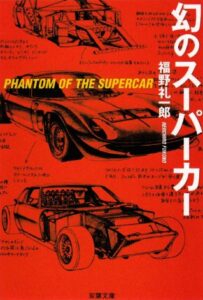
*バードケージ型のチュブラー・フレームがもたらす『ガチガチの剛性感』と
*その剛性がもたらす、峠・ワインディング・ロードでのパフォーマンスの素晴らしさ
の部分に感銘を受け、
わたしのなかでのLP400熱が再燃しました。
その後再び、LP400が頭を離れなくなり、
再び立体のLP400に注目するに至り、一昨年末とうとうこのミニカーに至りました。
#京商製 1/64 カウンタックLP400 (オレンジ)ランボルギーニミニカーコレクション
(ディテールなどはかなり大雑把な、800円ぐらいでコンビニで売られたものなのですが、CAD/CAM以前の原型師の手のぬくもりを感じる『一筆書き的な力強さに満ちた立体デッサン」が魅力、遠目で目線を下げてみた時のフォルムは本物以上、MR製1/43等と違い、タイヤとホイールのリアルさも絶品、感動しすぎて気が付くと、全色そろえてしまいました!!)

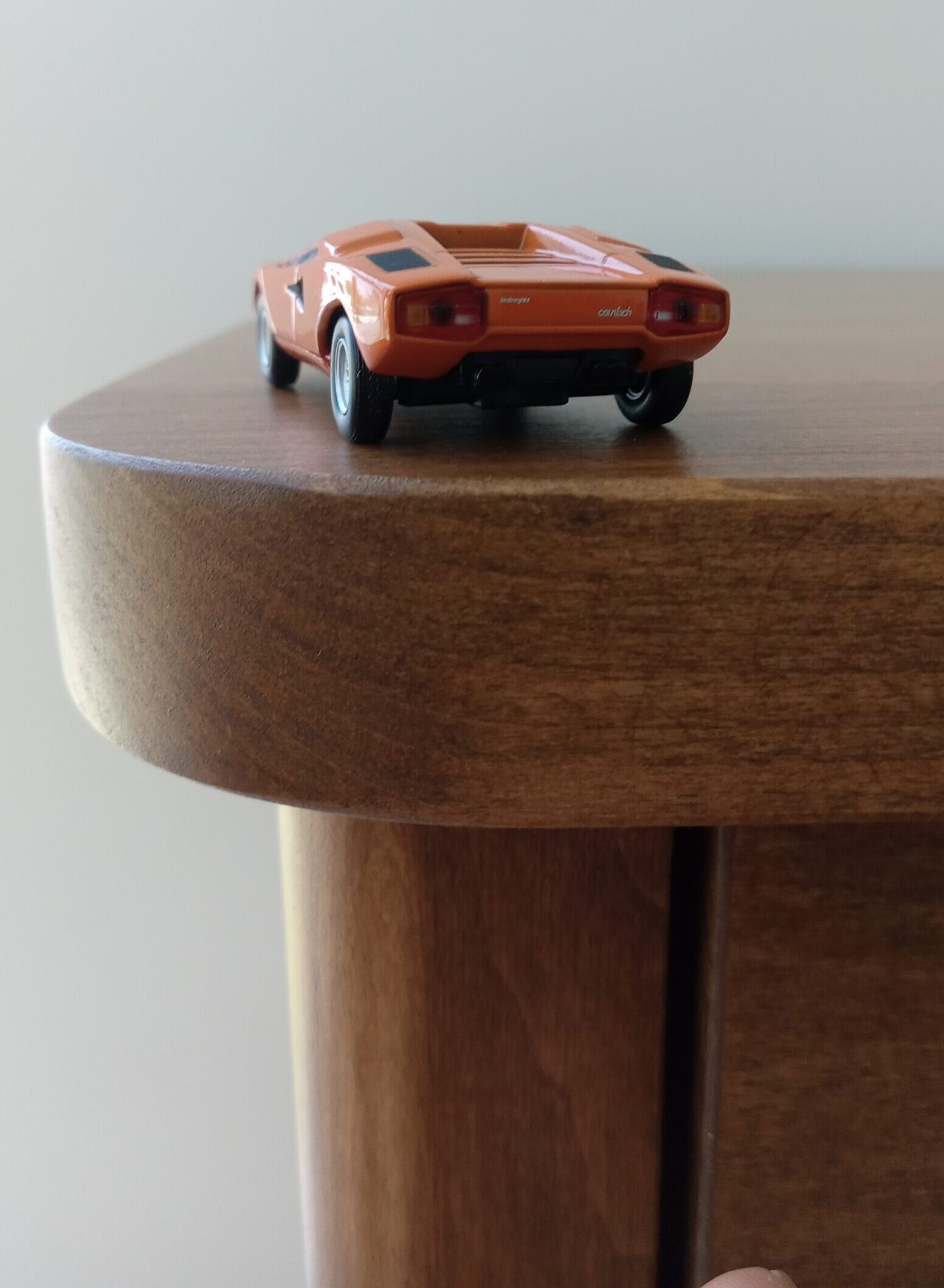
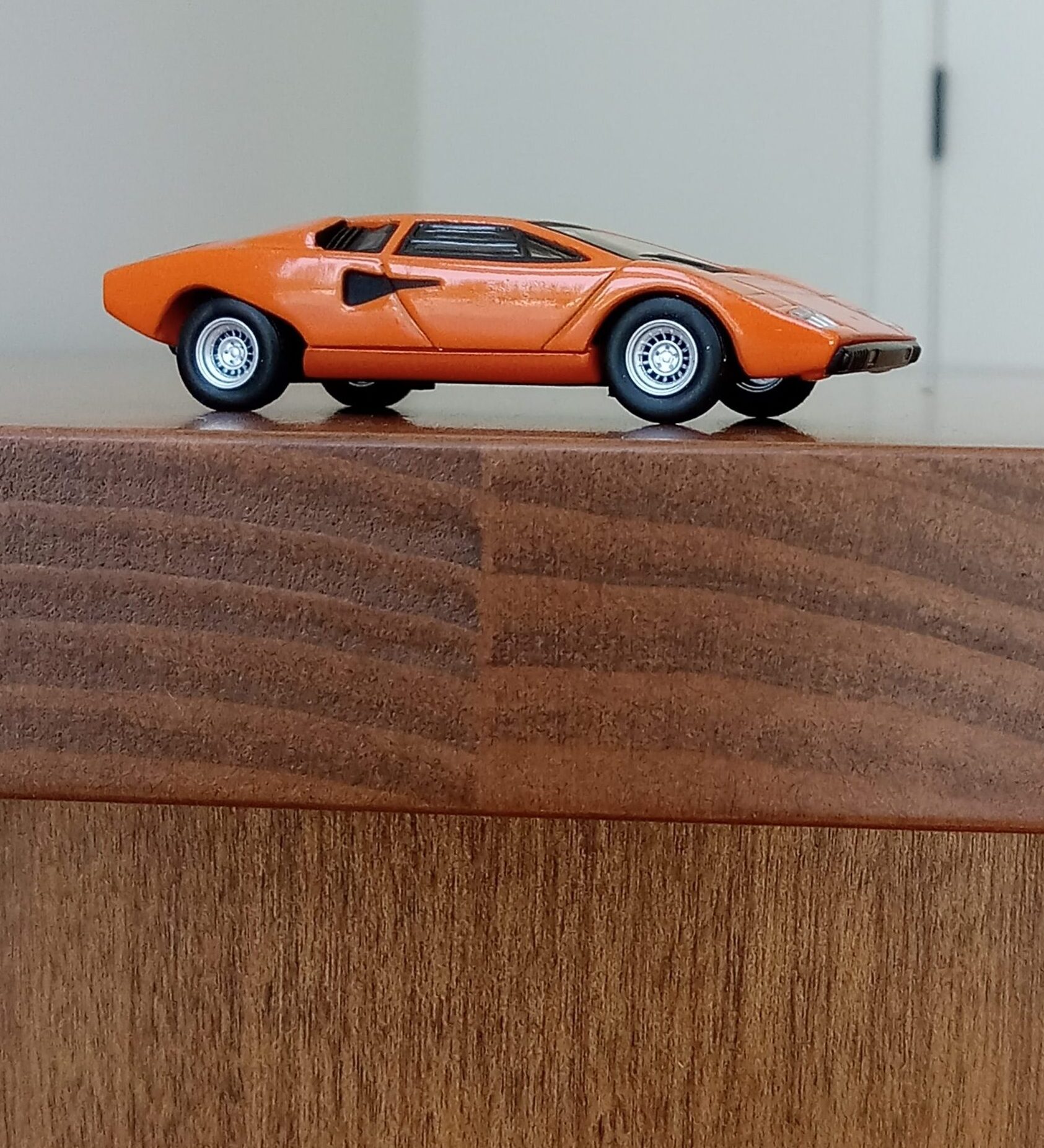
結論:ガンディー二の集大成=『超高速ダイヤモンド』
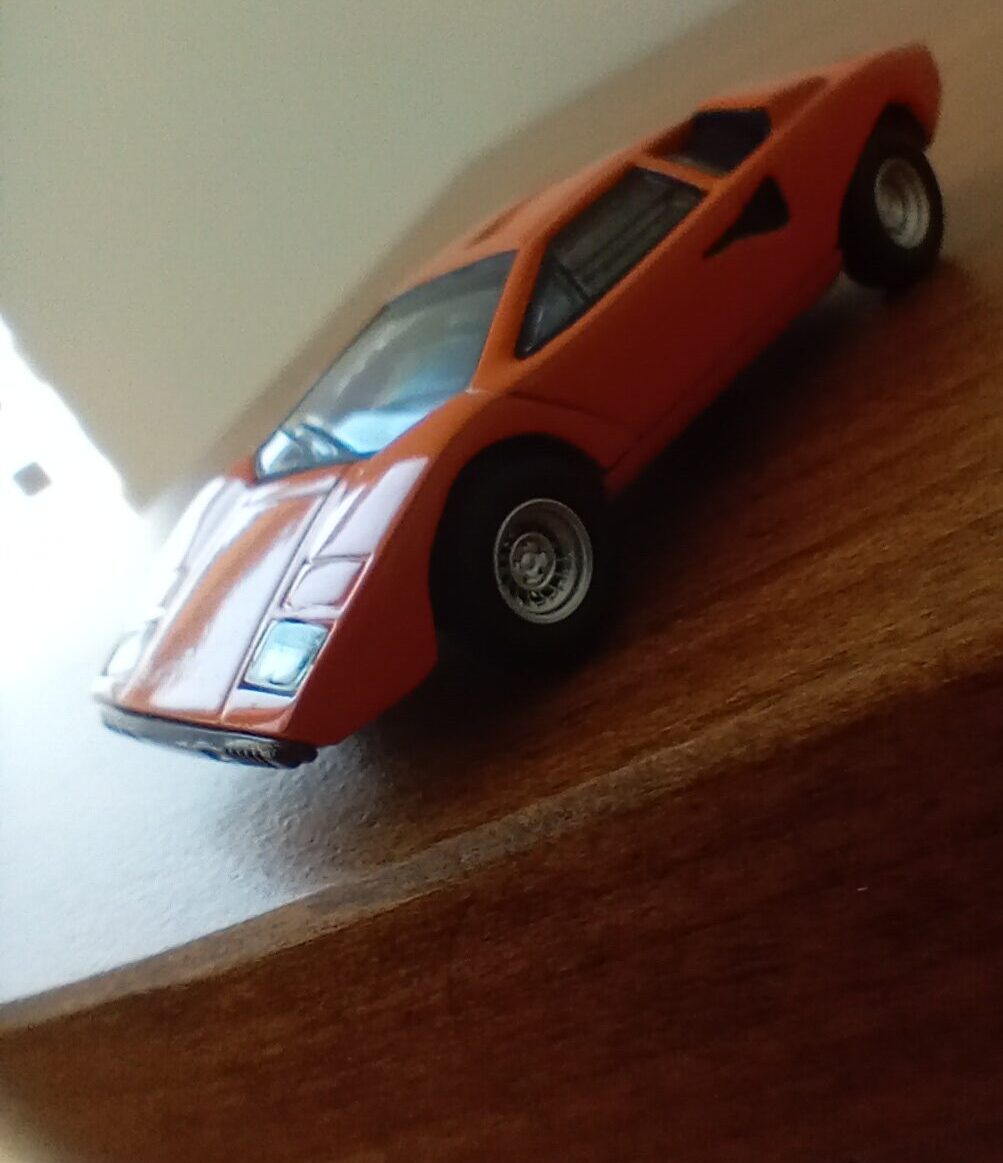
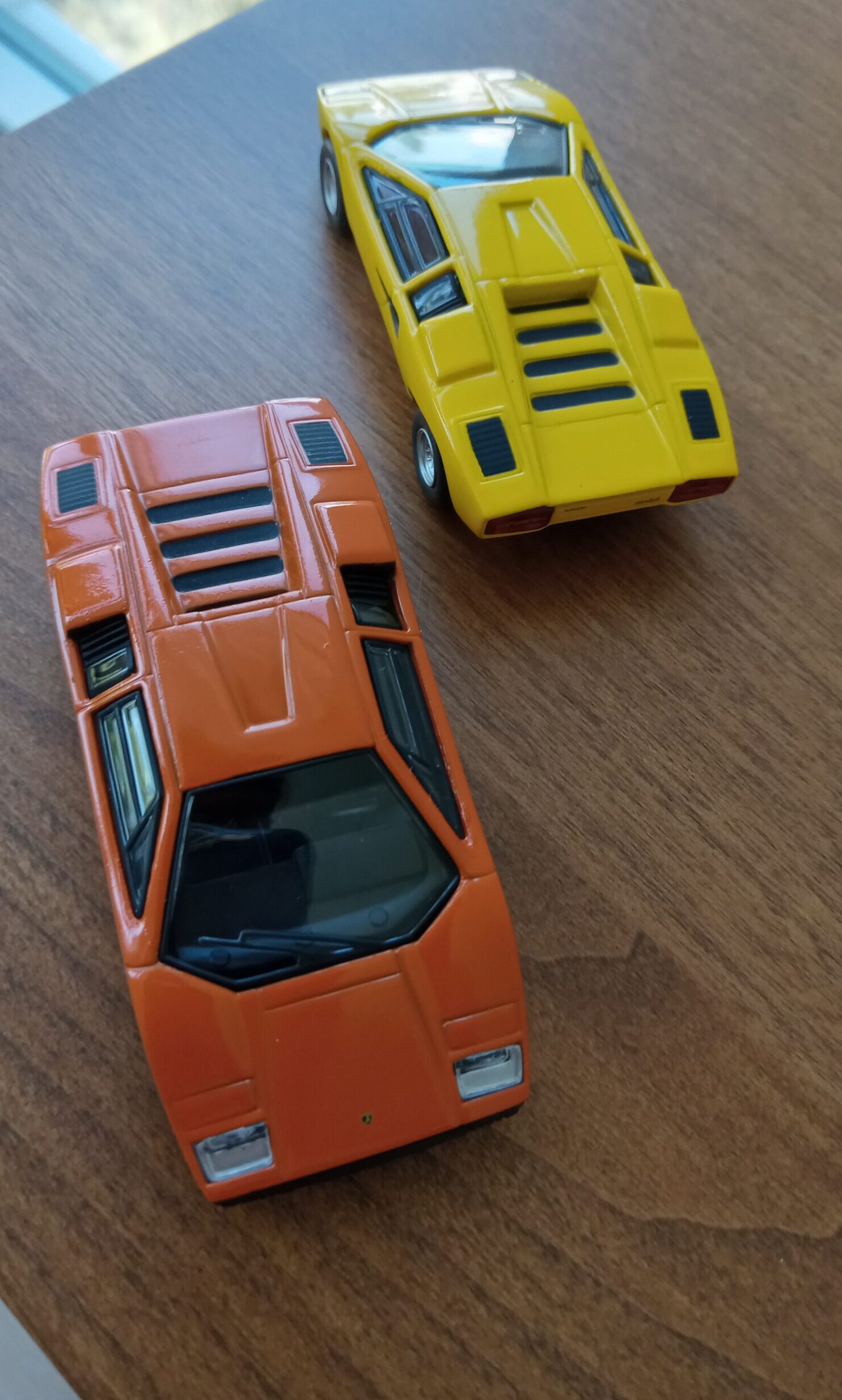
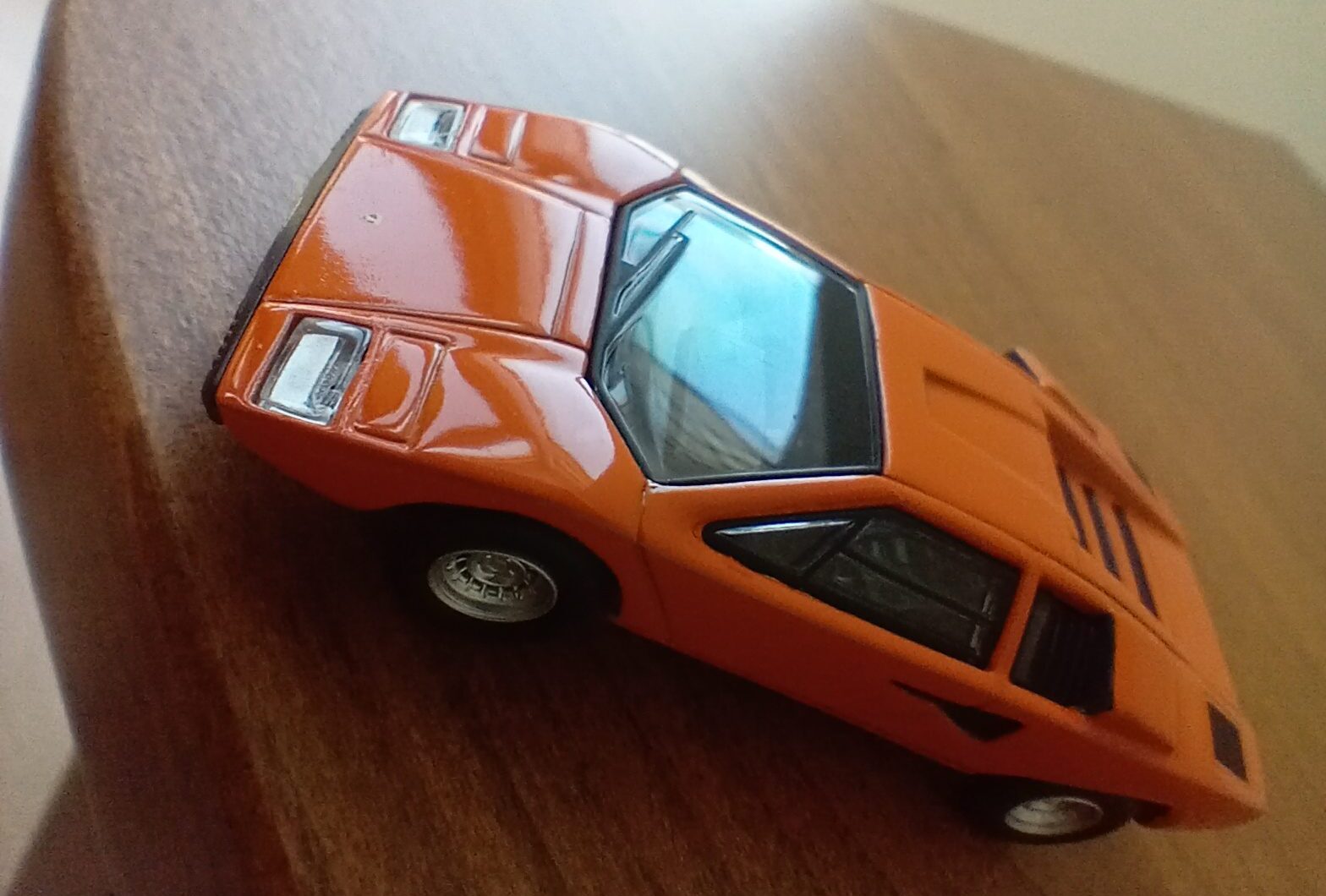
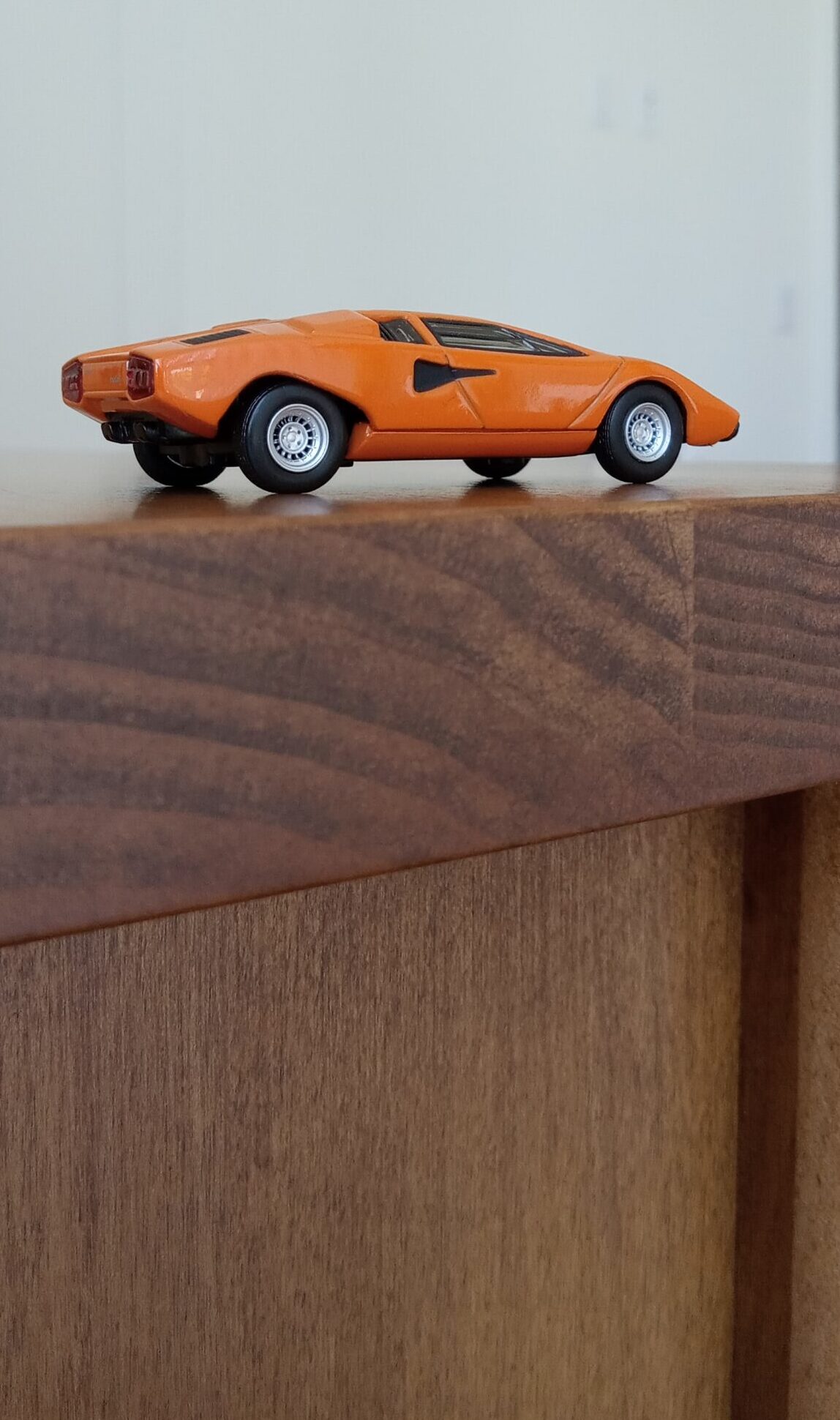
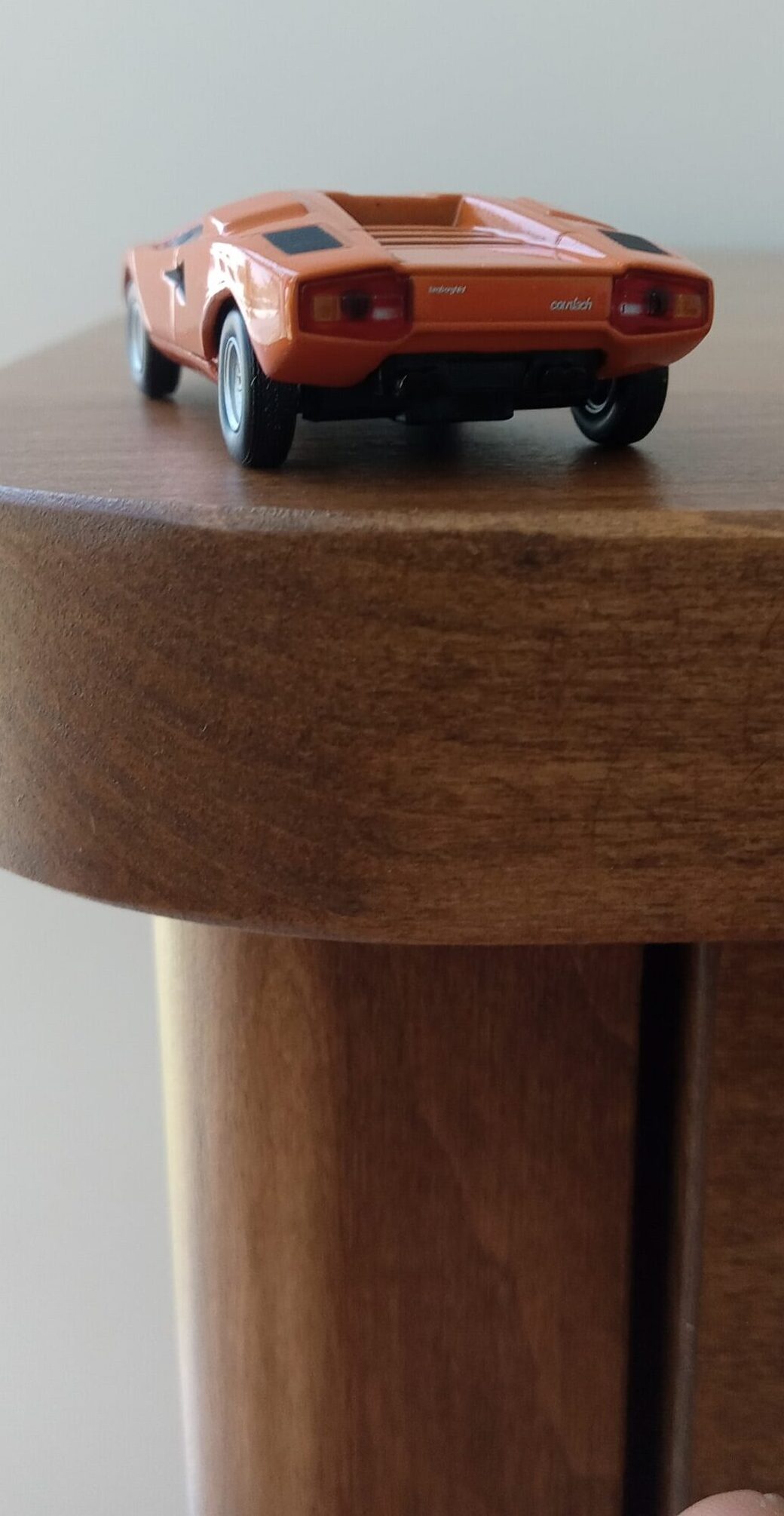
私の中で、
ランボルギーニ・カウンタックLP400とは、
数あるガンディーにの傑作デザインの
んん『集大成』であり、
スーパーカーの中のスーパーカー& 最高峰の逸品
実物の中につまりに、詰まった、シャーシ、エンジン、美的センス、スーパーカー少年の夢などが、
化学反応により形を変えた、
超硬質な剛性と密度とスピードのカタマリ=
んんんんんnつまり、『超高速のダイヤモンド』です。
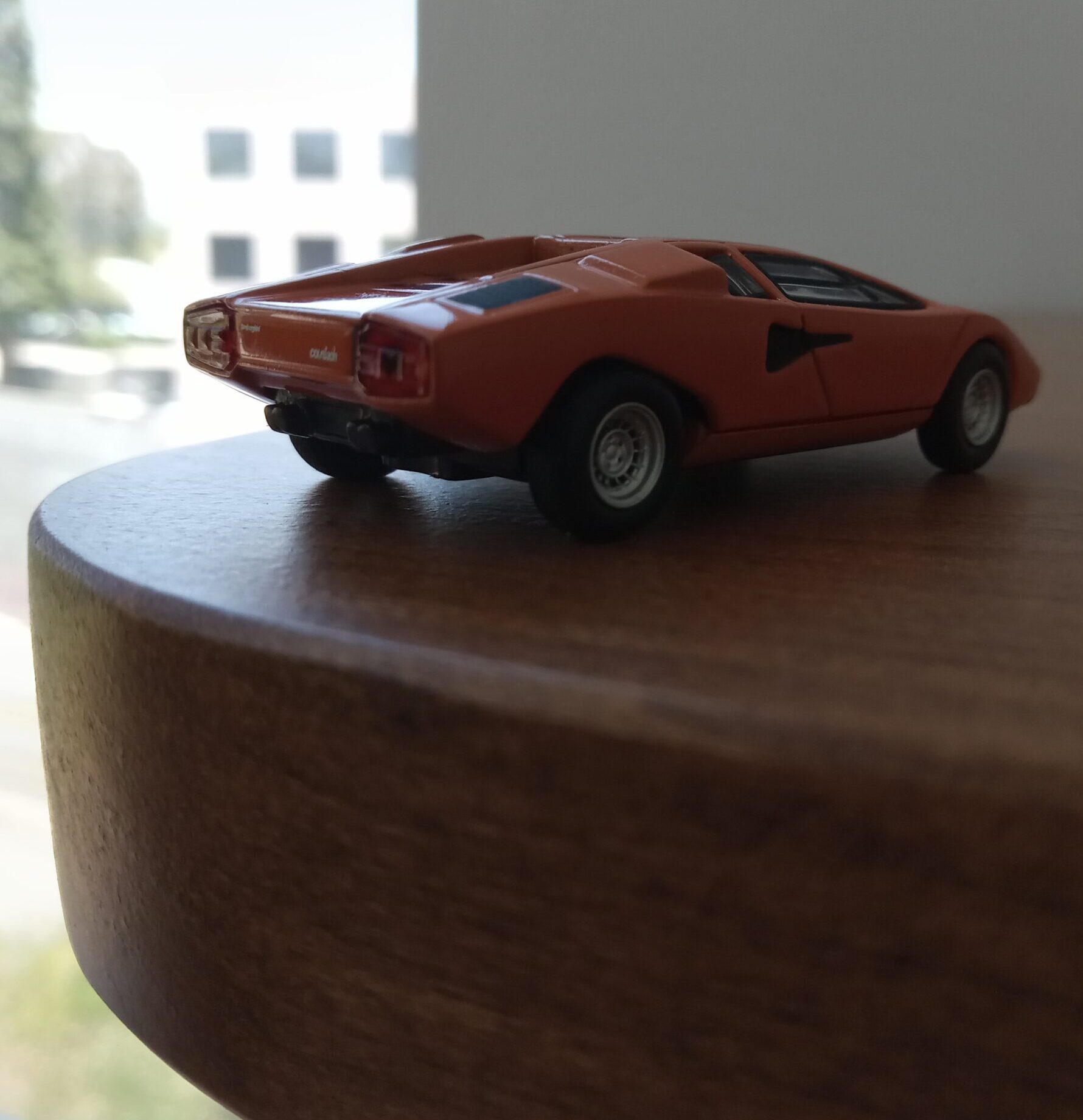
その他の:『スピード・ダイヤモンド』たち
カウンタックのような、
タイトで硬質な設計思想に貫かれた自動車がほかにあるのでしょうか?
私が知っているのはこんなところです、、、、
*ランチア・ストラトスHF, 1974 (イタリアン・レッドに金のホイール)(カウンタック以上に短い2m15cmというホイールベースの上にフェラーリディーノのV6を搭載した、回頭性のお化け、凝縮感あふれるウエッジシェイプはベルトーネ時代のガンディーニならでは。)
*マクラーレン・F1, 1992(シルバー)(鬼才、ゴードン・マレーによる贅を尽くした、センターコンソール型3人乗りパッケージ+市販車で世界初のカーボンシャーシーを採用。4m30cmの中にBMW製のV12,6リッターエンジンをおさめて1.2トンを切る、ぎちぎちパケージと空力を追求した外観が魅力。F1ブラバムBT46譲りのエアー掻き出し用の換気扇付き。笑)
*フェラーリ‣ラフェラーリ、2013 (フェラーリ・レッド)
(世界初のハイブリッド・スーパーカー、V12気筒のエンジンとモーターを合わせて、963馬力というモンスター。外観は、フェラーリのインハウスでデザインされ、1960年代のレースカーの面影がほんのりと見られるのがお茶目。)
こちらはあんまり、タイトなパッケージという訳ではないですが、ガンディー二繋がりということで、、、
*ランボルギーニ‣ミウラP400、1966(Yellow)
(大排気量エンジンをミッドシップへ搭載するスーパーカーの先駆者、ベルトーネ時代、前任者の大御所、ジウジアーロの残り香的に、珍しくガンディーニのネオ・クラッシックな味わいが覗く前後のフェンダーデザインが秀逸。 モダンアートの前衛作曲家の、学生時代無理やりやらされたクラシックの習作的な、、、、でも傑作みたいな?)
*マセラッティ・ブーメラン,1971(トリノ・ショーで発表)
(マセラッティ・ボーラの車体の上に、ジョルジェット・ジウジアーロ作の、これまた超クサビ形ボディーを載せた、ミッドシップ2座スポーツカーの習作。逆台形のボディーサイド断面がその強烈な存在感に貢献。ジウジアーロがインテリアのステアリング周りの一体化を追求していたころのデザインで、円筒型にまとまったステアリングコラム内に収まる操作系スイッチ群とメータ群は壮観の一言。)

どれも粒ぞろいな、
凝縮感あふれる(ミウラ以外は)金剛石デザインですね、、、
次回は、ついにデザインベスト10、第1位のオースチン・ヒーレー100/4(BN1)の選考理由ついて、私の体験を交えてお伝えいたします。
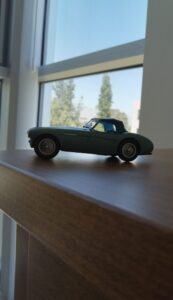
ーお楽しみにー
!!!!!!!!!!!!!!!!!!!!!!!!!!!!!!!!!! Translation in English !!!!!!!!!!!!!!!!!!!!!!!!!!!!!!!!!!
Top 10 Design List
Here is my subjective (lol)
top 10 list of automobile designs.
10th place: BMW 507, 1956 ———————— (Silver + matching hardtop)
9th place: AM General Hummer H1, 1992 —— (Military woodland camouflage)
8th place: MB 560 SEL, W126 model, 1979 —————— (Two-tone black and blue-gray)
7th place: Cadillac Eldorado, 1967 (Metallic blue with black leather top)
6th place: Toyota Prius, 2003 (2nd generation) —————————– (Seaside Pearl)
5th place: Honda S660, 2015 ——————— —————— (Star White Pearl)
4th place: Porsche 928, 1978 ————- (Light Blue Metallic with checkered interior)
3rd place: Citroën DS23 Pallas, 1973 ———————— (Champagne Gold)
2nd place: Lamborghini Countach LP400, 1974 ——————ーー (Orange)
1st place: Austin-Healey 100/4 (BN/1), 1953 – (Ivory and dark blue two-tone)
This time, I will talk about the general evaluation of the 2nd place, the 1974 Lamborghini Countach LP400 (Orange), and my personal “LP400 experience.”
2nd Place: Lamborghini Countach LP400, 1974
(Kyosho 1/64 Lamborghini Countach LP400 (Orange & Yellow)
For me, the Lamborghini Countach LP400 is,
before saying it’s cool or
amazing,
simply put,
‘rock-solid,
packed to the brim with…’
‘ultra-hard’
‘wedge-shaped,
ultra-high-speed diamond.’
Packing a massive V12 engine and transmission into an extremely compact volume of 4m14cm × 1m89cm × 1m7cm, and mounting them in the opposite direction from the norm—this creative package design, wrapped in an equally unconventional angular wedge-shaped exterior—is nothing short of a masterpiece. truly a ‘miracle creation’ born from the collaboration of two geniuses, Paolo Stanzani and Marcello Gandini.
Its unique shape is so original that there is nothing else like it. No matter where you cut it along the X, Y, or Z axes of three-dimensional space, the cross-section is always a hexagon, making it a “rolling diamond” that can move at high speeds.
Real car explanation: The “reverse mid-engine monster” born from lessons learned from the Miura
To address the instability during turns caused by the rearward weight bias of the previous Miura, chassis engineer Paolo Stanzani ingeniously solved the issue by mounting the massive engine and transmission in a reverse longitudinal configuration—a groundbreaking approach. Additionally, the radiator, typically positioned at the front of the chassis, was relocated to the space beside the engine, resulting in:
* Improved handling stability due to the center of mass being positioned at the vehicle’s center
* Enhanced engine cooling efficiency
* Improved access to the engine compartment
* Direct shift feel
These innovations successfully overcame the Miura’s weaknesses.
Furthermore, following the test driver’s suggestion to improve rigidity, the monocoque chassis was abandoned in favor of a classical space frame (birdcage-style tubular frame), resulting in a beautiful full-space frame constructed from welded steel tubes with diameters of 30mm, 25mm, and 15mm. This change achieved body and dynamic rigidity far surpassing that of the Miura.
(A highly compact package with all heavy components concentrated around the driver’s waist)
Covering this elegant tubular frame is the exterior design by the genius designer Marcello Gandini. The design theme is “propeller twist,” and it can be seen as a direct precursor to the styling of the Lamborghini Countach (1968) and Lancia Stratos HF Zero (1970), which Gandini had previously designed under the Bertone name. (1968) and Lancia Stratos HF Zero (1970) under the Bertone name, which can be considered the direct stylistic precursors to the Countach.
* Extreme wedge shape,
* Low, flat front,
* Trimmed tail end design
, among others, can be seen as the seeds of the Countach’s futuristic design. The Countach’s futuristic design was greeted with astonishment worldwide, as its name suggests.
The first-generation Countach series was produced from 1971 to 1998 with continuous improvements, selling a total of 1,999 units over 16 years. Many well-preserved examples still exist today, earning it the title of “the supercar among supercars.”
Selection Reason: Objective Evaluation of the Design
Next, we will focus on the exterior design and discuss its characteristics, themes, and motifs. (Here, we will only examine the early version LP400, as its exterior theme is clearly defined.)
We will explain the following points.
* The overall “wedge” shape of the body
(This is the most important theme that defines the Countach. Upon closer inspection, the “octagonal theme” mentioned later also contributes to the tuning of the wedge shape.)
* The theme of the upper surface of the body shoulders: “propeller twist”
(The angle of the surface, which was around 20 degrees at the side window area, gradually becomes about 5 degrees at the tail end, creating a ‘twist’ in the surface inspired by the twist of a propeller. This ‘twist’ interacts with the bulge of the rear fender in the side view, creating an indescribable sense of tension and uniqueness.)
* The ‘octagon’ and ‘trapezoid’ motifs seen throughout
(The ‘octagonal (hexagonal?)’ cross-section that appears when slicing the body along the X/Y axes, combined with the two-dimensional ‘trapezoidal’ theme seen throughout, visually reinforces the Countach’s ‘diamond-like’ rigidity. This is further enhanced by the actual tubular frame’s structural integrity, resulting in the ‘rock-solid’ body.)
Detailed designs that enhance the Countach’s appeal
* Original ‘scissor doors’
(The upward-opening ‘scissor doors,’ which originated with the Countach and became a symbol of the subsequent 12-cylinder flagship series)
* The distinctive “NC duct” as a graphic icon
(The “NC duct,” which strongly conveys directionality, also emphasizes the wedge shape.)
* The powerful design around the taillights
(The rear end, with its double hexagonal columns, looks and feels incredibly strong, both visually and physically!)
* The door cross-section’s tuck-in and distinctive fender arches
(The delicately fine-tuned lower cross-section of the body side ultimately shaves a significant portion of the body bottom, and in conjunction with the carefully opened rear wheel arches, subtly enhances the elegant grip of the bias-ply rear tires without being overshadowed by the fender flares introduced on the LP500S and later models)
Me and the Countach: “Awe-inspiring exclamation mark!!”
In the Piedmont dialect of northwestern Italy,
“What is this?!”
is an exclamation of astonishment,
and apparently that’s the meaning of the name “Countach.”
When I first saw it at the Super Car Show when I was in seventh grade,
in the Nagoya dialect of the Chubu region,
“Wow, that’s so cool!!”
(Translation: That’s really cool.)
was my reaction.
I had already known about it through Supercar erasers and plastic models made by Tokyo Marui and Aoshima,
but
“low, extremely low,”
“wide,”
“angular,”
“triangular (wedge-shaped?).”
I had no idea how to handle this outrageous-looking orange monster,
so I was in an excited state with M-kun, who had come with me, and kept taking photos with my unfamiliar camera.
There were also a Ferrari 512BB, a Pantera GTS, and a Lamborghini Miura at the show, but I don’t remember any of that. (Later, I realized that I had put the wrong film in the camera and didn’t take any photos… sob.)
The subsequent
“Encounter with the Countach”
When I was in the third year of middle school, after watching Ridley Scott’s horror sci-fi movie “Alien” with my younger brother, we discovered a yellow LP400 parked near the bus stop on our way home. My brother, who also loves cars, and I were staring at it intently, (I didn’t know someone was inside…) The middle-aged gentleman driving it said, “Let me give you a quick ride around here,” and pushed my brother, a Ferrari 512BB fan, aside. The LP400 with me inside took a light lap around Meijo Park (3–4 minutes) and returned.
My memories of the ride are as follows:
* The sense of security from the high center tunnel and thick door sills surrounding the passenger seat,
* Contrasting with that, the uneasy feeling of my short legs and unstable shoe soles swaying around,
* These ambivalent memories are faintly etched in my mind.
Having had such an experience,
(Years later, when I heard that the birdcage created an “amazing sense of rigidity,” something clicked.)
A three-dimensional “encounter story”
Next,
what are your experiences with plastic models, mini cars, and die-cast models?
*Tokyo Marui 1/24 Countach LP500 (Metallic Blue)
(A legendary kit that reproduces the detail of the “scissor doors” extending into the body. After staring at it intently multiple times, I noticed that the body was a bit too flat after watching the live-action film, and haven’t touched it since.)
*Tamiya 1/24 Countach LP400 (White Body)
(This one has a white body with a thicker profile, giving the body sides and front fenders a more rounded appearance. It doesn’t have the same impact as the Marui version, though…)
*Ootaki 1/12 Countach P400 (White Body) Not purchased
(This kit was at my regular model shop, and after observing the contents and opening and closing the lid for about 15 years, it disappeared. I remember that the rear chassis and rear suspension were very detailed, and the instruction manual was over 50 pages long.)
*1/43 Die-cast Miniature Car Collection
After graduating from university and moving to the US, I primarily interacted with the LP400 through 1/43 die-cast models.
#Mini Champs 1/43 Countach LP400 (Yellow)
(Typical Mini Champs approach, but the paint is too thick, and the door moldings are too soft.)
#MR x Kyosho collaboration product, Countach LP400 (doors, trunk, rear gate, and front all movable, metallic blue) (Well-made, but fragile, so I didn’t touch it much. The tires and wheels are not great.)
#Del Prado Countach LP500? (Prototype with black window frames and no reinforcement bars)
(My personal “number one” before I knew about Kyosho’s 1/64 scale models.
The balance between the design nuances, low profile, and fullness is superb, despite being a budget version.)
After that, my hobby shifted to customizing 1/6 scale action figures, so I hadn’t been in touch for a while, but by chance, I came to know Reiichiro Fukuno, and my eyes were drawn to his description of the Countach LP400 in his masterpiece, “The Phantom Supercar.”
* The “rock-solid rigidity” provided by the birdcage-type tubular frame, and
* The outstanding performance it delivers on mountain passes and winding roads.
After that, the LP400 kept coming back to my mind,
and I eventually focused on the 3D LP400 again, leading me to this mini car at the end of the year before last.
#Kyosho 1/64 Countach LP400 (Orange) Lamborghini Miniature Car Collection
(The details are quite rough, and it was sold at a convenience store for about 800 yen, but the appeal lies in the “three-dimensional drawing full of powerful strokes” that conveys the warmth of the hands of the prototype artist before the advent of CAD/CAM. When viewed from a distance with your eyes lowered, the form is even better than the real thing. Unlike the 1/43 scale model made by MR, the realism of the tires and wheels is exquisite. I was so impressed that before I knew it, I had collected all the colors!
Conclusion: Gandhi’s magnum opus = “Super High Speed Diamond”
The Lamborghini Countach LP400 is
the “magnum opus” of Gandhi’s many masterpiece designs
and
the supercar among supercars & the pinnacle of excellence
The chassis, engine, aesthetic sense, and dreams of a supercar boy are all packed into the real thing.
It is a super-hard, dense, and speedy lump =
“Ultra-High Speed Diamond.”
Others: “Speed Diamonds”
Are there any other cars like the Countach
that are designed with such a tight and hard design concept?
This is what I know…
This is what I know…
*Lamborghini Miura P400, 1966 (Yellow)
(A pioneer of supercars with a mid-mounted large-displacement engine, featuring Gandini’s neo-classic fender balance design from the Bertone era)
*Lancia Stratos HF, 1974 (Italian red with gold wheels)
(With a wheelbase of 2m15cm, shorter than the Countach, and equipped with a Ferrari Dino V6 engine, this car has superb maneuverability and a condensed wedge shape that is unique to Gandhi.
* McLaren F1, 1992 (silver)
(Designed by the genius Gordon Murray, this car features a center console and the world’s first carbon chassis in a commercial vehicle. It weighs less than 1.2 tons and is powered by a BMW V12 6-liter engine, all packed into a 4.3-meter body. Its attractive exterior is the result of a pursuit of aerodynamics and a tight package.
* Ferrari LaFerrari, 2013 (Ferrari red)
(The world’s first hybrid supercar, combining a V12 engine and motor to produce a monstrous 963 horsepower. The exterior was designed in-house by Ferrari, and it is playful in that it resembles a 1960s race car.
Each one is a gem, with a condensed, diamond-like design…
Next time, I will share my personal insights into the selection criteria for the top-ranked Austin-Healey 100/4 (BN1) in the Design Best 10 series.
—Stay tuned—
Translated with DeepL
これはCTAサンプルです。
内容を編集するか削除してください。

